
GUARANTEED SAFE & SECURE CHECKOUT

SOLAR PARADISE SUMMER SALE SHOP NOW!

Question? Call Us Now
(800) 557-4962
Mon-Sun 8am-8pm EST
- Your cart is currently empty.
- Portable Power Stations
- Solar Generators
- Solar Power Systems
- Solar Charge Controllers
- Wind Turbine Generators
- Air Conditioners
- Portable Solar Fridge Freezers
- Travel Kits
- Portable Solar Panels
- Foldable Solar Panels
- RV Solar Panels
- Flexible Solar Panels
- Marine Solar Panels
- Solar Water Heater Panels
- Briefcase Solar Panels
- Dual Fuel Generators
- Gasoline Generators
- Propane Generators
- Inverter Generators
- Portable Generators
- Deep Cycle Batteries
- LiFePO4 Batteries
- AGM Batteries
- Solar Kit Accesories
- EcoFlow Extra Batteries
- Portable Air Compressors
- Store Reviews
- Solar Paradise Financing
- Track Your Order
- Account Login
- Returns and Refunds
- Cancellation/Pre-order Policy
- Terms and Conditions
- Warranty Policy
- Become A Supplier
- Solar Finder Quiz
- 100% Best Price
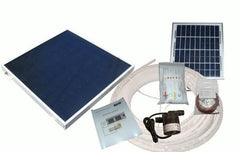
Heliatos Boat Solar Water Heater Kit
Choose Your Panel | Inventory
We'd love to hear from you!
- ✅ FREE Shipping + 5% Discount
- ✅ 100% Best Price Guarantee
- ✅ 1100+ Happy Clients
TALK TO OUR SOLAR PARADISE EXPERTS
Notify me when this product is available:
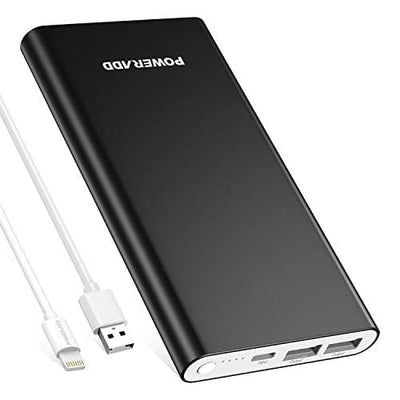
Choose Your Battery Bank Capacity | Solar Kit Size | Inventory
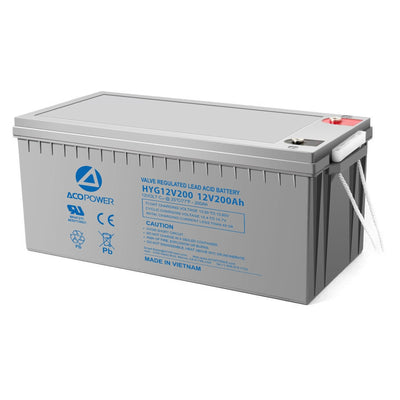
Choose Your Model | Inventory
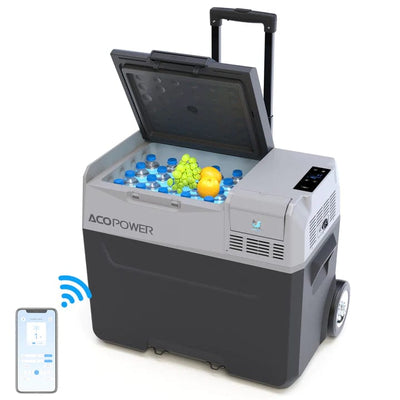
Choose Your Color | Inventory
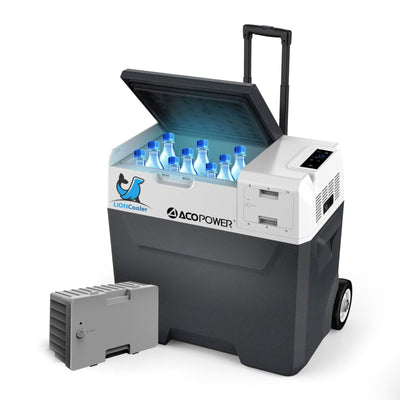
This kit contains everything you need to add a high quality solar water heater to your boat. The MH-38 panels connect directly to your hot water heater, without disconnecting your existing source of heat.
Our MH-38 panels include special features to prevent corrosion even in the harshest marine environments:
- Powder-coated frame and backing, gives the appearance of white enamel
- Zinc-phosphate internal corrosion protection
- Sealed construction
- Stainless steel hardware
These panels have unbreakable twinwall polycarbonate glazing, and a strong aluminum frame, yet only weighs 12 lbs.
Specifications
MH-38 Solar Panel
- Glazing: UV resistant twin wall polycarbonate
- Frame: Powder coated architectural grade aluminum alloy 6063
- Insulation: Polyiso foam (meets requirements for ASTM-C1289, Type 1
- specification)
- Water Conduit: Copper Tubing (Alloy C12200 certified for public water supplies meeting EPA Lead and Copper Rule 56 FR26460, June 7th, 1991)
- Fittings: Brass, Lead Free compliant with Federal Reduction of Lead in Drinking Water Act ,Dezincification resistant
- Internal Corrosion Protection: Zinc phosphate, polyurethane foam sealant, high endurance silicone
- Seals: Butyl rubber
- Length: 24.0 Inches
- Width: 25.25 Inches
- Height: 2.125 Inches
- Active Collector Area: 3.674 ft2
- Mounting Hole Spacing: 24.75 x 17.00 Inches x Inches
- Volume of Liquid in Collector: 7.7 fl. oz.
- Total Panel Weight: 14 lb.
- Input and Output Connections: 3/8 “ Compression Fitting
Maximum Ratings
- Pressure: 200 Psi
- Collector Temperature: 203 ºF
- Mounting Surface Unevenness: ¼ Inch (corner to corner)
Each Kit Comes With:
- Your selected quantity Heliatos MH-38 Solar Water Heating Panels
- 1 HS-21 Heliatos solar circulation pump
- 1 10 Watt PV Solar panel to power the pump
- Wire and PV panel mounting tabs
- 25 ft of 1/4" PEX tubing
- 1 Complete Set of Fittings and Adapters
- Assumes Marine water heater with 1/2" NPT connections (most common)
- Contact us for non-standard Water Heaters or Connections
- Clear and easy to follow installation instructions
All You Have To Supply Is:
- Fasteners to attach the panels
- Insulation for the tubing
- Your existing Marine water heater
- Tools needed for installation
View and Download
Installation instructions, sku numbers and options.
- 1 Panel - 077.0033
- 2 Panels - 077.0034
- 3 Panels- 077.0035
- 4 Panels - 077.0036
Order a Heliatos Boat Solar Water Heater Kit today from SolarParadise.com. Free shipping + free gifts on all of our Heliatos Solar Water Heater Kits. Buy today and get a discount, free shipping, and a free gift!
Customer Reviews
Worked fine. No complaints.
Let customers speak for us
I haven’t had a chance to experience a thing, because I have not been well, please give me a chance to feel better and get back to you. I’m sure I will be be very happy..
Have not opened up the packages yet. Waiting til needed. KNOW how great Bluetti is.... because of many many other sailors using it and having life-changing experiences 👍🏻👍🏻
So far the unit is doing good for one of our houseless individuals in our community. The sun doesn’t always shine thru the trees in his camp but it’s light enough to carry into town to it charged. He’s using it to run his CPAP at nighttime
Needs a carting case
Received my delta 2 very fast! the company was very friendly and knowledgeable on the phone.. everything work beautifully so iam very pleased... william H.
Practical Boat Owner
- Digital edition

How a boat solar hot water system works
- jonjwalmsley
- January 11, 2024
Jon Walmsley explains how to heat water without a diesel engine

Hot water makes light work of wash day on Ciel Bleu. Credit: Jon Walmsley Credit: Jon Walmsley
Dear PBO , In the Catamaran Refit article (PBO July 2023) in the section on hot water, the author, Jon Walmsley alludes to a ‘gizmo’ that diverts excess 12V power to a heating element thus utilising otherwise wasted power to heat the domestic water.
Is there any chance you could have a look at this concept and perhaps even produce an article on it?
So many boats these days have solar or wind to supplement their energy production and, in our case, the batteries are usually at 100% state-of-charge by lunchtime.
For the increasing number of electric boats, of course, engine-heated water is not an option.

How the solar hot water system works on Jon Walmsley’s catamaran Ciel Bleu
To be able to use the afternoon’s rays or wind to produce a tank full of hot water – or even just slow the cooling rate – would be fantastic.
Like many cruisers, I abhor the practice of running an engine or generator in a quiet anchorage just for battery charging or hot water, and even more so when this is done in the quiet of the evening which, for so many, seems to be the modus operandi these days. Whatever happened to the etiquette of conducting such things in the forenoon period?
Anything that PBO can do to bring this knowledge to a wider audience would, I’m sure, be greatly appreciated.
Jon Walmsley responds: When I purchased Ciel Bleu , a Fountaine Pajot Maldives 32, high on the list of upgrades for extended cruising was a hot water system for the galley and the heads.
Ciel Bleu is powered by an outboard engine instead of an inboard diesel.
While I’m not a qualified electrical engineer, and every installation will be different, hopefully my system will help readers develop their own solutions.
Pressurised hot water from a tap is easily achieved on most cruising boats by using waste heat from the inboard diesel engine .
Engine coolant is passed through a coil inside an insulated hot water tank, known as a calorifier , where it indirectly heats water supplied by the vessel’s cold water tank.
The calorifier normally has a 240V immersion, so that water can also be heated by a shoreside mains supply .
This solar hot water system works very well in most circumstances. Usually, only a half hour of motoring is enough to raise the temperature of the water in the tank to a useful level.

A dual 12V and 240V twin immersion heater covers you for cruising and shorepower
Remember that a typical diesel engine is less than 50% efficient, which means every kilowatt of mechanical power made correspondingly produces more than a kilowatt of heat.
Apart from the prerequisite of an inboard engine, there is one major drawback.
Unless the boat is in a marina, the production of hot water is entirely dependent upon the engine being run on a regular basis.
Until recently, when cruising, this was not an issue. Even when the boat was not underway the engine was run, at least daily, to charge the batteries.
The problem is that with the widespread installation of wind and solar systems by the cruising community, there is no need to run the engine for battery charging.

A digital thermostat prevents overheating and shows the current water temperature
Using the engine solely to heat water is wasteful and defeats the purpose of fitting solar panels .
What if, when the batteries are fully charged by renewables, any spare solar or wind energy could be used to heat water?
The first thing required is an element in the hot water tank that will heat water with the low voltage output of the solar panels.
If you already have a calorifier with a 240V element in it, you can do one of the following:
- Replace the element with a 12V version (simply putting 12V across a 240V element will not work). This is a good solution if you never have access to shore power.
- Fit a dual 12V and 240V twin immersion heater
- Add a separate 12V element to the tank using an Essex flange.
Whichever option you decide upon, you must make sure that a thermostat is fitted to each element.
The clever bit of the system is the voltage sensing relay. This measures the battery voltage and switches the solar energy to the 12V immersion at a preset level.
Similarly, when the battery voltage decreases to a preset level, the solar output is then reassigned to battery charging/load.
A digital voltage sensing relay (DVSR) allows you to configure the switching voltages depending on your preferences and the type of battery you have, ie lead acid or lithium.
Due to the large currents involved, the switching of solar output from the solar controller to the 12V immersion must be carried out by a relay of sufficient size to handle the maximum current of the solar system.
Similarly, for safety, circuit breakers and/or fuses of the appropriate size must be fitted to both sides of the solar controller.
Continues below…

Boat solar panels: Everything you need to know to get started
Want to add solar panels to your boat, or wonder how to make the most of those you already have?…

How to fit a marine hot water system to your boat
Today most new yachts come with pressurised hot water, but that wasn’t the case 20 or 30 years ago. Many…

Connecting boat solar panel chargers? Ask the experts
Barbara Mortimer writes: “I have a motorboat with three battery banks (engine, house and anchor winch) charged by the alternator…

What is insolation? How much power is reaching my boat’s solar panels?
The sun is 93 million miles away, give or take. Packets of energy called photons leave it and travel at…
Ciel Bleu has 400W of solar panels coupled to a 4kW lithium battery bank . There is a 300W 12V element in the calorifier.
When the solar hot water is switched off, the default is solar battery charging.
When switched on, the DVSR and the digital thermostat are powered up.
In practice, on sunny days there is sufficient spare solar to heat the water to temperatures in excess of 50°C.
A thermostatic mixing valve (TMV) reduces the water temperature to a more human-friendly 38°C and allows the hot water to go further.
It’s hard to find a downside to this system as the original method of heating the water is retained.
Enjoyed reading How a boat solar hot water system works?
A subscription to Practical Boat Owner magazine costs around 40% less than the cover price .
Print and digital editions are available through Magazines Direct – where you can also find the latest deals .
PBO is packed with information to help you get the most from boat ownership – whether sail or power.
- Take your DIY skills to the next level with trusted advice on boat maintenance and repairs
- Impartial in-depth gear reviews
- Practical cruising tips for making the most of your time afloat
Follow us on Facebook , Instagram, TikTok and Twitter
- Boat Equipment

- Remember me Not recommended on shared computers
Forgot your password?
Or sign in with one of these services
Solar Thermal Hot Water System

By Jen-in-Wellies October 17, 2018 in Boat Equipment
Featured Posts
Jen-in-wellies.
I've mentioned the solar hot water system on my boat a couple of times over my years on CWDF. After posting about the new control electronics, several people have asked if I could describe the system in detail as it may help others wanting to install something similar. This thread will hopefully contain all the details, divided in to a number of posts based around the various sub-systems. Any questions, or anything which is unclear, then please ask.
My boat was fitted out eleven years ago, with the intention of it being a full time liveaboard vessel, able to cruise in the Summer, but with a shore line available for the Winter. To that end, I wanted easy and reliable hot water available all year round. Heating was to be by solid fuel stove, so a back boiler in the Squirrel was used to supply one coil of a twin coil calorifer. For the summer it seemed sensible to give solar thermal water heating a try. The boat has solar photovoltaics to top up the batteries on summer days when not cruising, so engine running isn't required every day in summer when not on a shore line. The usual practice of having a calorifier coil connected to the engine and running it each day for hot water could be avoided by using the nearby day star for water heating.
A couple of pictures below of the roughly 8' x 4' solar collector on the roof, along with the more usual photovoltaic (PV) solar panels.
Link to comment
Share on other sites.
Solar Collector
Part Deux of the solar hot water epic tale.
At the time I installed my solar thermal set-up, there were several commercial systems available for domestic buildings. They divided in to two basic designs of collector, evacuated tube and flat plate. I looked at both types when selecting the one to use.
The data sheets for the evacuated tube collectors gave dire warnings of destruction if the circulating pump ever stopped while the sunshine was strong. They are also more susceptible to breakage from vandals and rather ugly looking. Both problems on a low canal roof, compared with a two storey building. They were therefore discounted and some form of flat plate collector decided on.
The pump system and piping also varied considerably between different manufacturers systems. Most were based on domestic central heating practice, using 15mm pipe and big central heating pumps. The pumps are 240V and consume lots of power. Not a good combination for a boat.
A couple of systems used low power, low voltage pumps, combined with small bore piping to the collector. Their argument was that a low flow rate allowed a higher temperature rise at the collector and good heat transfer from the coil to the water in the calorifier. One system used soft plastic piping for the collector and transfer pipe and was designed to directly heat domestic water circulated back and from the tank. This was claimed to be frost proof as the soft pipe could expand when frozen. I discounted this system as I was concerned by the long term life expectancy of the pipe.
The system I eventually selected was by Aton, a Dutch company. It no longer seems to be available, but their old UK distributor has kept their web site going for the benefit of former customers, so the information is still currently around . This used a copper flat plate collector with 8mm OD copper pipe soldered to it. Under the collector is extruded foam insulation and the transparent cover is a resilient plastic moulding. The collector is about 8' by 4' in size. It was designed to fit on to roof rafters, so needs a support frame. Originally I used a couple of pieces of 2"x4" wood, painted and bolted to the roof via rubber mounts. When the softwood reached the end of its life after around seven years, I replaced it with aluminium U channel. The collector is very light and has withstood the occasional vandals stone over the years in the networks less salubrious locations. It was easy to dismantle and store inside the cabin when preparing the boat for Standedge Tunnel.
The panel is mounted horizontally. It is meant to be mounted on a pitched south facing roof, but to supply a typical house hot water tank, so I reckoned that flat mounting would suit a smaller boat calorifier (60 litres). Flat mounting means the hardware is simpler, you don't have to worry about lowering it for cruising, or proof it against wind loads in a storm.
If I were building my own collector from scratch I would use aluminium sheet and tie copper tube to it with wire at regular intervals (see numerous on-line guides and Youtube videos), or use copper sheet and solder the tube as the Aton panel is. Copper sheet is much more expensive than aluminium and harder to find for sale, but it has much better thermal conductivity, so the pipes can be spaced further apart. There is also reduced risk of electrolytic corrosion as you could get with aluminium sheet to copper pipe contact. The Aton panel has a single 8mm OD copper pipe soldered to the copper sheet that winds back and forth across the width of the sheet in a serpentine pattern. The pitch between each pass of the pipe is around 5". I would use 50mm thick Celotex/Kingspan extruded foam insulation underneath, as per the Aton panel. I would probably use PVC sheet for the sides that can be easily solvent welded together and a transparent polycarbonate panel for the top to give good light transmission, appearance, life span and vandal resistance.
Plumbing and Pumping
Another thrilling episode. Buy the series on DVD!
Pipework too and from the collector is 8mm OD copper, as used for domestic microbore central heating systems and readily available, with compression fittings, from plumbers merchants. Flow goes from the pump, through the collector, back down to the calorifier, through the 15mm cauliflower coil, then back to the pump. There is insulation on most of the pipe runs to prevent heat loss before it can reach the calorifier. I used black 40mm PVC waste water drain pipe over the insulation where it is outside the boat to protect the foam from sun UV damage. The pipework is taken through the roof with through bulkhead fittings.
The pump is a low power 24V one. The Aton system is powered by a single 20W solar panel that originally ran both the pump and control electronics. This produces around 19V open circuit, so the 24V pump is under-run. The solar thermal electrics and PV panel, as I installed it, is independent of the boats 12V electrics and solar PV panels.
These days, the control electronics is run from the boat 12V supply via a step down module to 5V, but the pump is still on the 19V unregulated 20W panel, switched via a relay. A similar system could be built with a 12V pump, worked off the boats normal domestic supply. The pump is very quiet. I have tried a smaller cheap ebay 12V pump that gave similar flow rates as an experiment, but it was very noisy and its life expectancy is unknown. It is kept as a spare, in case the 24V one fails.
Frost protection was provided by a check valve. When the pump switches off, the weight of water going up to the roof opens the check valve, allowing air in to the pipework. The water then drains back by gravity to the header tank. The small bore piping allows this to happen as it works as a capilliary tube. When the pump starts again, the pressure closes the check valve and the coolant circulates back up through the collector. This has not been reliable. At first it worked well, but after a while both the original and a replacement check valve wouldn't open reliably. Possibly this would work better on a house installation with a greater head to a roof collector provides more suction to help open the check valve. Without a reliable drain back valve the system needs antifreeze to protect the external pipework and collector. I used propylene glycol antifreeze as this isn't poisonous, unlike ethylene glycol. One winter I had allowed the antifreeze concentration to fall too low and did get frost damage to the collector that had to be fixed.
The pump, drain back valve, header tank and filter were originally contained in a drain back unit supplied by Aton. This used plastic pneumatic pipe and fittings inside. After a number of years these fittings started to leak. Possibly the antifreeze degraded the o-ring seals. I therefore built a new unit, replicating the design, using the existing pump and filter, but with metal pipework and fittings and a drain back tank made from a Midland Swindlers header tank . See the picture below. I've labelled it, so it acts as a plumbing diagram too.
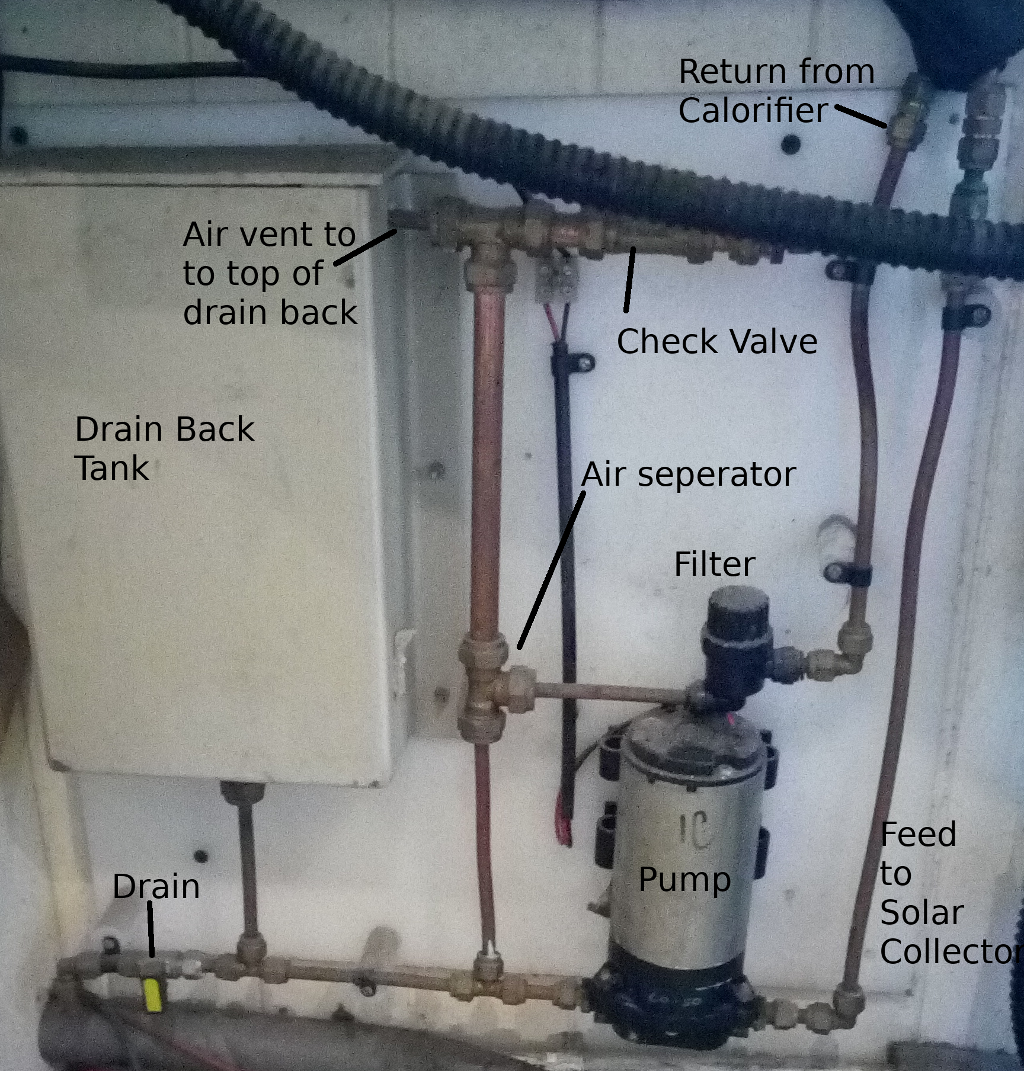
Control Electronics
Book Four of the Trilogy.
The control system is almost as simple as it could get. A single light dependent resistor is mounted on the roof. As the sunshine gets stronger the resistance decreases. At a preset level the controller switches on the pump. There are delays in there so that passing clouds don't have the pump cycling on and off. A thermistor needs to be on the calorifier to measure the temperature and disable the pump if the calorifier gets too hot and risks boiling. I fitted this by cutting a slit in the insulation and poking the thermistor to the bottom to sit against the copper cylinder, near the top. A second thermistor is used to work a calorifier temperature gauge on the control panel. There is also an hours run meter that counts when the pump is on. More sophisticated control is possible, measuring temperatures at the calorifier and panel, but this method has worked very well.
After ten years use I found the controller on threshold had drifted and the pump wasn't being switched on when useful heat could still be extracted. A new panel and control electronics, with combined cauliflower temperature indicators was built. This will be detailed in another post.
Photos below of the 20W solar panel that powers the circulation pump and a close up of the light dependent resistor. This is mounted in a small cable gland, with a transparent polycarbonate window araldited on top to weatherproof it.
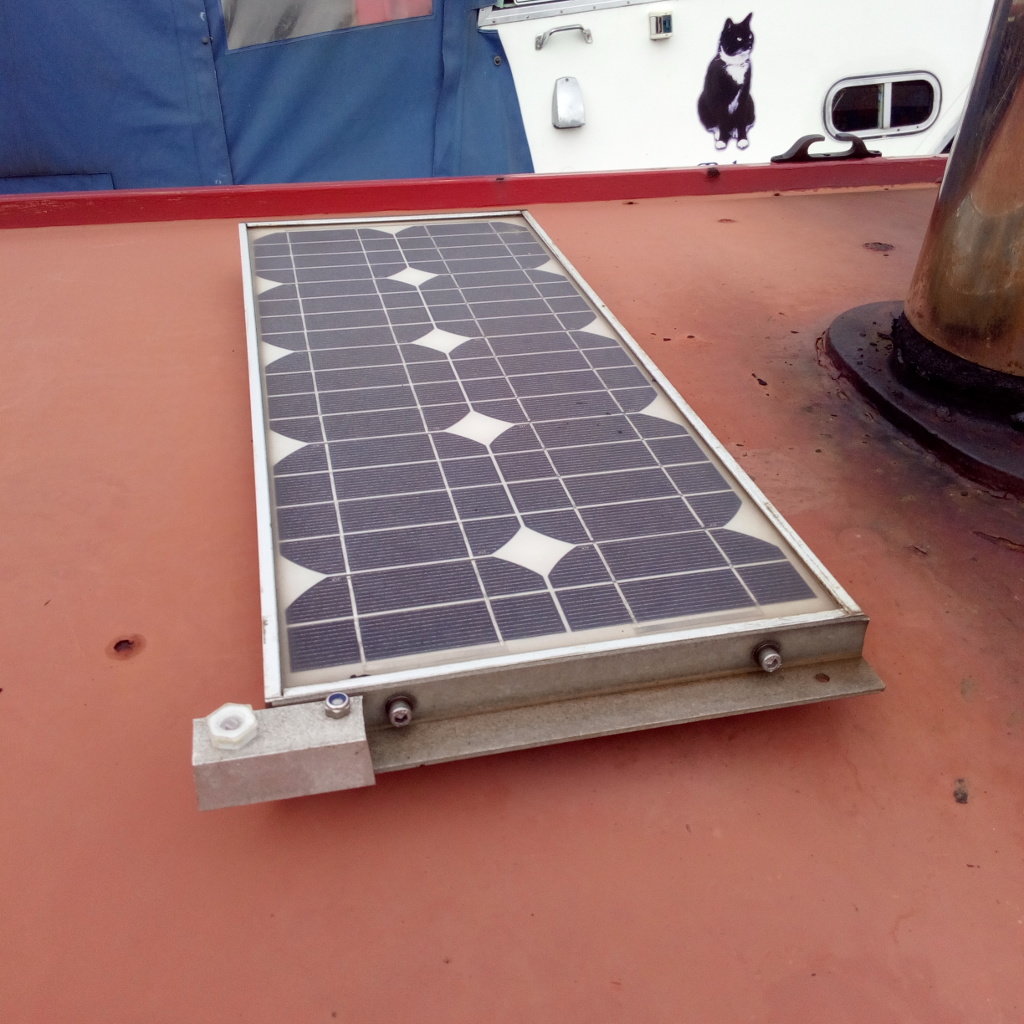
Performance
Season finale.
In general, I get a tank of hot water on most days during the summer, from May till September. There are a couple of weeks in Spring and Autumn where it isn't hot enough for solar water, but not cold enough to light the stove which are annoying. The only problematic days in Summer are those that are overcast with heavy rain, which are just not bright enough for the pump to run. An overcast summer is usually enough to get the water at least hot enough for a bath, or shower when you come home, 30 to 35C, but will have cooled down by the morning. Warmer days will get it up to 60C, which with the thermostatic mixing valve on the calorifier gives more hot water than you can use and still be over 40C by the morning. You have to plan your usage, particularly for laundry using a twin tub, or other hot fill machine, around the weather. I've not found this to be a chore. The temperature gauge on the control panel is very useful to help decide how you are going to use the hot water.
This system has worked well right from the start, but has needed quiet a bit of replacement and upgrading over the years to get round the failings in the Aton design.
Next season I'll go in to the design of the new control electronics.

we're in the process of setting something similar up for next summer in our house, although using central heating radiators painted matt black embedded in foam and covered with perspex (all stuff we have kicking around)
the biggest thing we have found is the need to heat the water in the immersion to above 60 degrees regularly to reduce the chances of legionnaires
our solution was a small program on an arduino that monitors time and temperature of the water and if it reaches 3 PM and the water hasn't gone over 60 deg in the last 48 hours it will switch on the immersion heater until the temp reaches 65 deg
the reason 3 pm was chosen as the time was to allow for weaker sun to heat the water as much as possible before falling back to electric, if it hasn't got it up to temp by 3 pm it isn't likely to do it with the remaining sunlight that day
1 minute ago, Jess-- said: we're in the process of setting something similar up for next summer in our house, although using central heating radiators painted matt black embedded in foam and covered with perspex (all stuff we have kicking around) the biggest thing we have found is the need to heat the water in the immersion to above 60 degrees regularly to reduce the chances of legionnaires our solution was a small program on an arduino that monitors time and temperature of the water and if it reaches 3 PM and the water hasn't gone over 60 deg in the last 48 hours it will switch on the immersion heater until the temp reaches 65 deg the reason 3 pm was chosen as the time was to allow for weaker sun to heat the water as much as possible before falling back to electric, if it hasn't got it up to temp by 3 pm it isn't likely to do it with the remaining sunlight that day
Good thinking with the immersion heater. Legionella is a risk and getting the tank over 60C on regular occasions will sterilise it nicely.

Thanks for posting. Very informative.
One question. Is the drainback tank still required if you are using antifreeze in the system?
1 minute ago, rusty69 said: Thanks for posting. Very informative. One question. Is the drainback tank still required if you are using antifreeze in the system?
With antifreeze, the drain down check valve doesn't have to work, or even be present, so the drainback tank acts more as a header and expansion tank. My system is open ventilated, so unpressurised and does evaporate coolant, requiring regular checking and topping up. A more sophisticated approach would be a sealed system with expansion vessel. My plumbing knowledge isn't up to that, but someone who knew their stuff could no doubt do it.
5 minutes ago, Jen-in-Wellies said: With antifreeze, the drain down check valve doesn't have to work, or even be present, so the drainback tank acts more as a header and expansion tank. My system is open ventilated, so unpressurised and does evaporate coolant, requiring regular checking and topping up. A more sophisticated approach would be a sealed system with expansion vessel. My plumbing knowledge isn't up to that, but someone who knew their stuff could no doubt do it. Jen
Thanks. I was surprised when my collector split in many places when it froze one winter. I thought, i had drained it properly (obviously not). I wonder if the drainback works better if the panels are tilted, as they probably would be on a house installation.
1 minute ago, rusty69 said: Thanks. I was surprised when my collector split in many places when it froze one winter. I thought, i had drained it properly (obviously not). I wonder if the drainback works better if the panels are tilted, as they probably would be on a house installation.
Definitely. The Aton instructions were very firm that there should be no downhill sections in the pipework for the capilliary drain back to work properly and they assume that the panels would be tilted, either mounted on a pitched roof, or a suitable frame.
There are all sorts of solar thermal controllers around. Most measure the temperature at the collector and compare it with that at the storage tank before deciding when to turn on the pump. A simple one that you can build yourself, or buy ready made is described here . No experience with this, but it looks like it should work well.
What I'll describe here is the Arduino based controller I built to replace the original Aton controller, when that had drifted in calibration.
The system on my boat is based on measuring the sunshine intensity with a light dependant resistor (LDR) on the roof of the boat. When the sun is bright enough, the pump is turned on. There is also temperature measurement of the top of the calorifier. This disables the pump if the calorifier risks overheating. It also raises the sunshine turn on threshold at higher calorifier temperatures to reduce the risk of the pump circulation actually cooling the calorifier.
There is a delay programmed in that means that the light level must be above the threshold for a set length of time before the pump turns on. Similarly, it must fall below a threshold for a set time before turning off. This prevents the pump turning on and off with every passing cloud.
The Arduino Uno works on 5V, so the boats 12V supply is stepped down with a suitable module .
Temperature at the calorifier is measured with a T092 packaged LM35 integrated circuit. This outputs 10mV for each degree centigrade from 0C upwards. There is a nice Arduino library that works well with this. There is a resistor and capacitor in series between the signal and ground lines by the IC to make the output more stable over the 1m or so of cable between the calorifier and controller. This is described in the LM35 data sheet. The LM35, passives and connecting wires were soldered to a small piece of veroboard and encapsulated in some heat shrink tube to protect them, leaving the plastic LM35 body exposed. The LM35 was tied to the face of a nut on a brass fitting at the top of the calorifier with a cable tie, then the whole thing insulated with foam pipe lagging.
The pump-on output signal from the Arduino is fed to an optically isolated relay module to actuate the pump.
There is an on/off switch and a DPDT centre off switch. This second switch has three positions: Auto allows the pump to be controlled by the Arduino from sunshine and calorifier temperature values. Off disables the pump and turns the controller in to a simple temperature monitoring and display unit. On overides the Arduino, with the exception of the safety temperature limit measurement and runs the pump all the time when there is enough power being produced by the small 20W solar panel.
Power on, temperature and pump running are displayed with a series of six 5mm LED's. The pump running LED is a flashing one with built in flash control circuitry. The other LED's are simple ones of appropriate colours. The current limiting resistors are selected based on the forward bias voltage and current limit of the LED, which vary depending on the colour. All the Arduino pins used for these LEDs, with the exception of pump-on are pulse width modulation (PWM) pins. As the different colour LED's are of different brightness, the PWM output is altered for each LED to match their brightness. There is a second LDR mounted in the face of the panel to measure the cabin light level. This light level is also used to alter the PWM output on the LED pins, so as the cabin gets darker the LED's dim and go out when the cabin is dark. This makes the LED's less distracting.
The two LDR's and the LM35 signal go to Analogue in pins on the Arduino. The LDR's are part of resistance dividers with a suitably sized resistor to produce a voltage in to the input pin. The sunshine measurement LDR's resistor is a variable one, 200 ohms, set to its mid point of 100 ohms. This allows sunshine pump threshold adjustment in hardware as well as in software by adjusting the trim pot.
Below is the Arduino sketch, for anyone interested. The LED temperature indicators work OK, with 5C precision. It would have been equally easy to use a digital display, either LED, or LCD to give a more precise reading down to 1C and if I was building this again I would probably have used an LCD display, with the backlight triggered by the cabin LDR. If you know Arduino stuff, then this should hopefully make sense as I've documented it.
7 minutes ago, Jen-in-Wellies said: A simple one that you can build yourself, or buy ready made is described here . No experience with this, but it looks like it should work well.
That is the one i used. It did work well for the short time i used it, along with a cheap Chinese pump.

3 hours ago, Jen-in-Wellies said: The pump is a low power 24V one.
3 hours ago, Jen-in-Wellies said: . The pump is very quiet. I have tried a smaller cheap ebay 12V pump that gave similar flow rates as an experiment, but it was very noisy and its life expectancy is unknown.
Could you tell the board which 24v pump exactly, is so quiet, please?
Many thanks...
9 hours ago, Mike the Boilerman said: And Could you tell the board which 24v pump exactly, is so quiet, please? Many thanks...
I wish I could. There are no makers name, or part number on it, aside from Made in America moulded in. I have tried to find it elsewhere, but never succeeded.

14 hours ago, Jen-in-Wellies said: The only problematic days in Summer are those that are overcast with heavy rain, which are just not bright enough for the pump to run.
Wouldn’t a temp comparator as opposed to an LDR be a better solution then? Isn’t that why most controllers use that system?
Obviously you’d still need the over-temp safeguard.
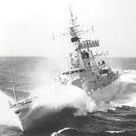
Do I have to fit one of these please miss or can I still run my lovely fossil fueled engine for an hour to have scalding hot water for the day? oh and several amps chucked into the batteries at the same time ?
4 minutes ago, mrsmelly said: Do I have to fit one of these please miss or can I still run my lovely fossil fueled engine for an hour to have scalding hot water for the day? oh and several amps chucked into the batteries at the same time ?
It's useful if you don't fancy moving for a few days and already have solar putting power into your batteries, it means you don't need to run your engine at all.
for our experiment next year it will be tied into the existing water heating system taking us up to 4 ways of heating the same tank of water 1. heat from big wood burner (hot water + rads) 2. heat from oil burner (hot water + rads) 3. heat from solar (hot water only) 4. heat from immersion elements (hot water only)
we're luck that our house has a totally clear southern exposure which means that anything on that side of the house gets uninterrupted sun from 6am through to 6pm (picture below was taken at 6pm and you can see we are just about to lose the sun on the south side.
the only reason that there aren't solar panels all over the roof (apart from the fact that the roof is shot) is that I did the maths and worked out that it would take around 18 years to break even on the installation costs assuming the system performs perfectly with no failures, any failures (panel failure or grid tie inverter failure) would push that figure out further
53 minutes ago, WotEver said: Wouldn’t a temp comparator as opposed to an LDR be a better solution then? Isn’t that why most controllers use that system? Obviously you’d still need the over-temp safeguard.
Quiet possibly. I have described what I have done, not necessarily whatever is the best way of doing it. I don't pretend it is the ultimate system, only one that has worked reasonably well for the last decade. There is a trade off between time and money spent developing something and the incremental improvements to be made. I am happy with something that works. At some point the enthusiasm may strike and I'll look at temperature comparitors. Would be an easy thing to incorporate in to the current controller with a second LM35 in the collector going to another analogue in pin. Would need time spent data logging and analysing the results in the summer to optimise the control method.
49 minutes ago, mrsmelly said: Do I have to fit one of these please miss or can I still run my lovely fossil fueled engine for an hour to have scalding hot water for the day? oh and several amps chucked into the batteries at the same time ?
Absolutely you have to fit one. What are you standing around for? Get building! ?

TheBiscuits
https://www.bimblesolar.com/thermal/thermal-kits/boat-solar-thermal-kit
I spotted this kit at Bimble, so thought I'd add it to this discussion.
33 minutes ago, Jess-- said: the only reason that there aren't solar panels all over the roof (apart from the fact that the roof is shot) is that I did the maths and worked out that it would take around 18 years to break even on the installation costs assuming the system performs perfectly with no failures, any failures (panel failure or grid tie inverter failure) would push that figure out further
Buy some secondhand panels - £85 for 250W at Bimble at the moment.
The economics of solar panels has been pure tax farming for years, but as the subsidy continues to drop they are significantly cheaper than they used to be. We have now gone from "stick these on your roof and the government will pay you £££ for twenty years" to (more expensive) electricity generated at home.
As with most solar systems, if you can use it or store it yourself, they make sense. Maybe you just need a cheap electric car to use the panel output!
4 minutes ago, TheBiscuits said: https://www.bimblesolar.com/thermal/thermal-kits/boat-solar-thermal-kit I spotted this kit at Bimble, so thought I'd add it to this discussion.
Interesting. The first time I have ever seen one marketed to boaters. Looks like it heats the water directly in the panel, rather than indirectly. Would need draining down for the winter.
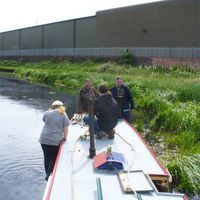
Tom and Bex
Very interesting to see that Bimble kit (although not cheap). I wonder what panel they use? Can't see it listed separately on their site. Flat plate panels (particularly robust ones) are not common but definitely better suited for boats.
We've installed a thermal panel earlier this year, using a second hand flat panel from eBay just resting on wooden bearers on the roof, this controller, and this pump. All connected using 10mm plastic push fit pipe and fittings from toolstation.
Unfortunately we have no spare coil in calorifier, and no immersion heater boss to fit one, so had to plumb it direct. This means we can't use antifreeze, so have to drain down for winter (although the controller has an anti freeze setting that circulates water in freezing conditions - ideal for cold nights in spring/autumn but you lose any remaining hot water).
Using push fit plumbing, lever valves, and a waterproof plug for panel sensor, it's quick and easy to, turn pump off, disconnect panel, and remove it (5 mins max). We often remove it when cruising as it's very fragile, and already had one panel broken in Birmingham, that's why I'm interested in alternative panels that may be more durable. All that's left on roof when removed, is a small black box with a plug, and couple 10mm pipe stubs showing.
All in all a very worthwhile investment, particularly this summer! We had tank full of piping hot water most days, even after doing couple loads of laundry. Combined with solar PV we could go for week or more without running heating or engine (except to fill up with water!)

6 hours ago, Tom and Bex said: Very interesting to see that Bimble kit (although not cheap). I wonder what panel they use?
Don't know but it looks similar to the Navitron Fino one, however that one is only about about 1m2 which is half the size of the Bimble one:
https://www.navitron.org.uk/fino-flat-plate-solar-hot-water-panel
1 minute ago, smileypete said: Don't know but it looks similar to the Navitron Fino one, however that one is only about about 1m2 which is half the size of the Bimble one: https://www.navitron.org.uk/fino-flat-plate-solar-hot-water-panel
That is the one I had.Picked it up of fleabay for 50 quid.It really would have benefitted from having two,as it was a bit small.

" When the sun is bright enough, the pump is turned on. There is also temperature measurement of the top of the calorifier. This disables the pump if the calorifier risks overheating."
So in bright sun when the calorifier is fully up to temperature, the pump is switched off. Doesn't that lead to even higher water temperatures in the collector? Boiling?
Create an account or sign in to comment
You need to be a member in order to leave a comment
Create an account
Sign up for a new account in our community. It's easy!
Already have an account? Sign in here.
Recently Browsing 0 members
- No registered users viewing this page.
- Existing Member? Sign In
- Featured topics
- Privacy Policy
- All Activity
My Activity Streams
- View New Content
- View New Content (Inc. Political)
- Leaderboard
- Rules & Guidelines
- Create New...
Important Information
We have placed cookies on your device to help make this website better. You can adjust your cookie settings , otherwise we'll assume you're okay to continue.

- Forum Listing
- Marketplace
- Advanced Search
- About The Boat
- Gear & Maintenance
- SailNet is a forum community dedicated to Sailing enthusiasts. Come join the discussion about sailing, modifications, classifieds, troubleshooting, repairs, reviews, maintenance, and more!
solar hot water
- Add to quote
Crew Has anyone out there in sailing land seen, or built a sloar hot water system for their sailboat? I'm looking around for a design to roof mount on Clarity, but if it's been done successfully I'd appresiate hearing about it. Cheers. Bill
These work really well, stow well when not in use and are reasonably priced. Sometimes simple is good. Rik
Really, they are awesome. Even in the PNW where sun is scarce they are good. If you can't get the water quite hot enough, a kettle of warmed or boiling water will get it to the right temp. Also, buy the biggest one they make. Even if you don't need all the capacity the extra surface area will help it get hot faster. My two "Sun Shower" brand showers (now owned by Stearns) are still going strong after 10 years of abuse and neglect. They also have a temperature indicator on them (think forehead thermometer) which is nice as well. MedSailor
How about one of those non marking black hoses.
I had a friend who tried that in Eastern Washington (where it is very sunny and hot in the summer) and it ended up not working. Apparently there was a lot of heat loss in all the surface area of the tubing and the tubing of large enough diameter (1/2") that the middle never got very warm. On the other hand our swimming pool in Australia has a system that used a very small pump and a bunch of very thin rubber tubing (1/8" diameter probably) that had flanges on it to make the black rubber surface area larger. It added quite a few degrees (maybe 10?) to our outdoor pool. It was something like this: Hot Sun Flexible Solar Swimming Pool Heating Collector Panels It seems that the solar pool heating industry has quite a few offerings that would fit the bill. There are even good instruction manuals and diagrams that show how to make the system. Hot Sun Flexible Solar Swimming Pool Heating Collector Panels Just substitute your "tank" for their "pool" and you should be good to go. This one in particular (linked above) looks good because the rubber is flexible and can be run anywhere that is convenient on the boat. Nice idea BTW. Let us know how it turns out! MedSailor
I haven't, but I've thought about it. Because I have four separate water tanks, I've thought of insulating one, and using a solar pump and vacuum tubes to make it a hot water tank. Haven't even experimented yet, but I would mock it up first with a five gallon bucket before I altered the plumbing.
My boat has never had a hot water heater installed. I have no interest in a shower in the head, but would like to have it readily available in the galley. My plan is to get a 6 gallon marine hot water heater and run it on electric when on shorepower but not hook it up to the engine cooling system as per usual for use when off the grid. I don't want to run the engine just to heat water. My thought is to circulate (with a low-volume solar-powered pump) warm/hot water through the heater through a modest-sized cabintop collector when not on shorepower. I'm going to experiment with it before next season to see if it's feasible before trying it on the boat. Mobnets 1973 Chance 32/28 "Westwind"
Mobnets said: My boat has never had a hot water heater installed. I have no interest in a shower in the head, but would like to have it readily available in the galley. My plan is to get a 6 gallon marine hot water heater and run it on electric when on shorepower but not hook it up to the engine cooling system as per usual for use when off the grid. I don't want to run the engine just to heat water. My thought is to circulate (with a low-volume solar-powered pump) warm/hot water through the heater through a modest-sized cabintop collector when not on shorepower. I'm going to experiment with it before next season to see if it's feasible before trying it on the boat. Mobnets 1973 Chance 32/28 "Westwind" Click to expand...
Sunshower more then enough for our needs. When we were in mexico we had to put a T-shirt around the thing as the water was way TOO hot for showering.....
Seems to be an overly complicated work around to a already acceptable low cost solution, i.e. the solar shower. There are a couple of threads on this already that should be eyeballed. One simple solution for 'whole tank' heating is a solar panel that once it's done charging panels shunts power to the hot water heater - and again - that's already out there in the world (heat sinks etc..) No need to re-invent the wheel as it were.
I had a small sample solar panel from Heliodyne that we used to haul around for the shows & considered this very thing. it would have fit perfectly off arear rail but there are several issues to be dealt with taking this approach. You need a controller to monitor the temperature difference between the collector & the hot water tank so that a circulator pump runs only when the temperature in the panel is greater than the water tank. You could try circulation by gravity but then you'd have no control over the system. In the evening just opposite would happen, you'be be heating the outdoors from the tank. The other issue becomes stagnation. What to do with the hot water in the collector when the hot water heater is fully charged. You wouldn't want a dump valve for the panels given the potable water storage capacity on most boats. When you just look at the energy involved to operate a system such as this, it makes no sense for a sailboat. I think the sun showers are the way to go if you're looking for "free" hot water. Easy, fool proof & they don't take up any real estate.
Points well taken. I've used the Solar Shower in the cockpit with good results. I guess I should worry about where I'm going to install the 6 gallon hot water heater first. In the end, I would be happy with an electric only heater just to use while on shore power in the slip. Mobnets 1973 Chance 32/28 "Westwind"
I have a small 110v water heater on my boat and in the 2 years I have owned it, I never even tried the thing out to see if it works. I am actually planning to take it out next month, storage would be a much better use of my space. I have a solar shower and usually use it up on deck. If I am feeling modest I just put the hose in through the port in my head where my shower is and viola hot shower. Also can use it to do dishes. During the summer I had to keep it in the shade because it became too hot a couple times.
Before we bought her I thought the idea of a separate shower on a boat to be a complete nonsense. Now I have sign above the door - "This way to Damascus". No need to wipe out the head after a shower, pleasant roomy space that holds a mountain of gear when heading offshore. That said .... in summer months a solar on deck is a fine idea even though we do have a cockpit shower but in winter I love that hot shower of an evening. Now, if there was a way to set up a decent solar hot water heater on a boat I'd be right into that though I suspect it is simply not feasible with current technology. There has to be a good reason why hot water heaters (tanked) on boats do not offer a 12v heating option and I suspect the size of the necessary solar array is the reason. Betcha that changes in the next few years.
tdw said: Now, if there was a way to set up a decent solar hot water heater on a boat I'd be right into that though I suspect it is simply not feasible with current technology. There has to be a good reason why hot water heaters (tanked) on boats do not offer a 12v heating option and I suspect the size of the necessary solar array is the reason. Betcha that changes in the next few years. Click to expand...
I've been using a clear plastic pesticide sprayer, 3 gallons I think. Find it to be a lot handier than the traditional solar shower, don't have to hang it up, just pump up the pressure and use the hose. I was thinking about painting it black but since I spend most of my time in Florida and the Bahamas I ended up leaving it in the shade most of the time. Somebody's making a marine version but I just bought a cheapo model at a discount store. You can get them in different capacities and can usually adapt different spray heads if you want to. Google pesticide sprayer.
- ?
- 176.1K members
Top Contributors this Month
Yachting Monthly
- Digital edition

Sailing with solar power: A practical guide
- Duncan Kent
- November 13, 2020
The latest solar technology makes self-sufficient cruising much more achievable. Duncan Kent gives the lowdown on everything you need to get your boat sorted

SOLAR POWER ON BOARD
Solar power is fast becoming the most popular and economic method of keeping the batteries charged on a boat.
Particularly now that the efficiency of photovoltaic (PV) panels, charge controllers and batteries is improving every day.
Furthermore, the latest technology in regulators and charge controllers has brought about a noticeable increase in useable power output, so the problems of shading and non-alignment can be compensated for more easily.
Not only has PV equipment become more efficient and cost-effective, but many of the modern devices we want to use on a boat have become less power hungry.
This means it is now far easier to provide your entire yacht’s electrical needs, both 220Vac and 12/24Vdc, from natural energy resources – particularly solar power, even if you are planning on a fully electric boat .

Thinking carefully about how much power you need and how much your boat can accommodate is key to planning a solar array. Credit: Graham Snook
WHAT DO YOU NEED?
For instance, a boat with two new, good quality, deep-cycle house batteries of 100Ah each would supply 100Ah of energy to consume between charges, if you only use the recommended 50% of available charge between each charge cycle to protect the batteries.
From this you could run:
- a modern 12Vdc fridge (approx. 1.5Ah, or 36Ah over 24hrs),
- all LED lighting (say 20Ah per day),
- various small device chargers (20Ah)
- and a number of other items such as water pumps, TVs and stereos (25Ah/day)
- Totalling around 100Ah.
- For this you’d need 400W of solar capacity.
Of course, if you like to run a lot of AC devices off-grid such as hair dryers, microwaves, toasters and the like, then you’re going to need a DC/ AC inverter, which will take you to another level in power consumption terms.
But even then, with careful planning, solar could provide a large portion of the power you need before resorting to engine charging or a generator.
THE AVAILABLE SPACE
In practical terms, a modern 40ft monohull would have the space for around 1,200W of PV panels (cockpit arch, sprayhood top, deck), maybe 1,500W with the addition of a few portable panels for use at anchor.
The 1,200W of fixed position solar array could produce around 360Ah on a sunny summer’s day (zero shading) or more likely 250Ah on the average UK summer’s day.
So that’s enough for your 100Ah general DC consumption plus another 150Ah of AC consumption via the inverter.
Of course, to do this you’ll most likely need to increase your battery capacity to around 400-500Ah for maximum flexibility (you’ll need to store as much as possible during daylight hours), a typical figure for a 40-50ft offshore cruising yacht these days.

Get your solar charging right and you may never need to hook up to shore power
Typical daily inverter loads for a cruising yacht off grid might be:
- induction cooking plate (20min) 60Ah
- microwave (15min) 30Ah
- coffee maker (20mins) 25Ah
- hair dryer (5min) 15Ah
- laptop charger (2h) 10Ah
- or around 140Ah in total.
The trick is to monitor the batteries’ state of charge (SOC) at all times and vary your use of the inverter to suit.
For example, you might want to cook supper mid-afternoon, when solar is in abundance, and then reheat it in the evening when you want to eat it.
In some cases, when you’re cruising in warm climates such as the Med, you might end up with excess charge from your solar panels .
In this situation, many long-term cruisers devise a method of ‘dumping’ the extra energy by heating water for showers.
Do bear in mind if you’re planning to live aboard full time , then it’ll be a whole different story on cloudy days and during the winter, when inverter use might need to be knocked on the head entirely.
Continues below…

Eco friendly sailing: Best practice for green yachting
How easy is it to go eco friendly sailing? We look at the steps cruisers can take to minimise their…

How and where to go wild cruising in the UK
Planning to spend the night away from crowded waters can be truly rewarding but preparation is essential before you go…

Solar-powered boat crosses Atlantic
Then heads to UN climate conference
POWER DISCREPANCIES
There’s often confusion as to how much power you can harvest from a solar installation.
A PV panel is nearly always advertised stating its theoretical peak output power (Pw).
But in reality, on a yacht where there are limited areas in which to mount them, they will more likely produce a maximum of 60% of their peak output if mounted horizontally, increasing to 80% if tilted towards the sun and regularly adjusted.
The latter is rarely achievable on a boat, however, as even at anchor it can swing through an arc of 180° in wind or tidal shifts .

Flexible panels can be mounted on sprayhoods or awnings to add power when it’s needed at anchor or in harbour
INSTALLATION
Having trawled through hundreds of ‘deals’ to get the best price on the most efficient panels you can afford you now need to know how to install them to best fulfill your energy generation needs.
The output, even from the highest quality photo-voltaic array, will only be as good as the installation itself.
So following our guidelines should ensure you extract every last drop of energy from your investment.
PANEL MOUNTING
Sailing boats are not the ideal structure on which to mount wide, flat PV panels.
So before you go ahead and purchase what looks like the biggest and best, take a few minutes to decide on exactly where you can mount them, as this will affect what size and type of panels you should buy.
In many cases the first choice would be on an arch, davits or gantry aft, especially if you already have, or plan to fit one.

Dinghy davits, particularly on multihulls, can support a huge solar capacity
These allow a solid metal framework to be constructed that will be strong enough to take the heavier, more productive rigid PV panels.
You can also build in some form of adjuster to the framework that will allow the panels to be orientated towards the sun for the best performance.
With luck (or careful planning) a gantry will also keep them aft of the boom, thereby eliminating loss of output caused by boom shading.
The next most popular position for mounting the panels is on a cockpit sprayhood or bimini, although this will often mean using the flexible or semi-flexible panels, which are generally less efficient than the rigid ones for the same area.
ELEVATED MOUNTING
Alternatively, there are kits available for mounting panels onto lifelines, which can allow their elevation to be manually adjusted to a certain degree.

Pole-mounted panels can be used for maximum adjustability
Finally, panels can be fitted directly onto the deck by either gluing them down using mastic or attaching them onto a rigid support frame.
Once again you will probably need to use semi-flexible panels – especially if the deck surface is curved.
Rigid, glass-coated panels will obviously not be suitable for deck mounting in an area that is frequently walked over.
Don’t be tempted to drill through the panels, even along the edges, as this will invalidate the warranty and possibly damage the panel.

With solid panels, the ability to adjust the angle can add significantly to output
It might seem obvious, but the key to an efficient system is to avoid shading wherever possible.
It’s no good fitting expensive, high-efficiency PVs right under the boom as they’ll perform little better than the cheaper types.
Saying that, in good quality panels each cell will be isolated from the next by a series of diodes (one-way electrical valves), so that if one cell is shaded at least it won’t drag down the other cells within the same panel.
Older panels often didn’t have these, so the slightest partial shading caused the output of the entire panel to cease.
OVERHEATING
Another important factor that is often ignored when installing the panels is that of overheating.
If a PV panel gets too hot, which is quite likely if mounted directly onto a flat surface without an air gap behind, its output will drop quite noticeably.
To allow for some air circulation behind the panels it’s best to apply mastic adhesive in numerous large dabs.
This is best achieved by placing wooden spacer strips between the dabs until the mastic has completely cured, after which the spacers can be removed.
You might need some form of trim around one or more of the outside edges, though, if they are positioned where sheets and other lines might get caught under them.
Raising the panels up will also help water to drain off and thereby helping to avoid possible delamination from sitting in water for too long.
CHARGE CONTROL
A PV module cannot supply an electrical device directly due to the changeability of the sunlight, which in turns varies the current it can produce.
Therefore, it has to be connected to a battery, which stores and smooths its output.
Whatever the size of your solar array you will need to fit a regulator, or charge controller as they are now more commonly known, to the system in order to control the output and to help extract as much power from the panels as possible.
There are two types of PV charge controller.
The older designs, called Pulse Width Modulation (PWM) types, were fairly basic voltage regulators and simply output volts at just above battery level.
The latest controllers use Multi Power Point Tracking (MPPT) technology and can accept much higher input voltages (up to 240Vdc).
MPPT controllers can be up to 30% more efficient as they use the peak output of the panels to charge the batteries, even compensating for partial shading.
BEWARE FAKE GEAR
If you buy online do be careful to ensure you’re getting what you pay for.
There are a huge number of fake MPPTs out there, which are simply the much cheaper PWM dressed up with fake labels.
It’s hard to tell which is which, but the old adage of ‘if it looks too good to be true, it usually is’ makes good sense.
MPPT controllers are usually bigger and heavier than PWMs, but if in doubt call or email the supplier to discuss the pros and cons of their kit before buying.
If they’re not happy to chat and advise you then I would steer clear of their gear.
Some good MPPTs are made in China, but unless they have a UK supplier, I wouldn’t bother with them as you’ll have no follow-up advice.
To calculate what size controller you need simply divide the panel’s peak power in Watts (Wp) by the battery voltage, which will give you the maximum current (Amps) they could theoretically supply.
For example 240W/12V = 20A. Although it’s unlikely you’ll ever get near the peak output from any PV panel, it’s best to go for the maximum possible.

Induction cooking is now a reality on board, even without shore power
PV panels come with a short length of cable, usually around 1m long.
Some are supplied with MC4 connectors already attached but most only provide bare wires.
The latter can be easily extended using proper waterproof connections but thought must be given as to the current rating and voltage drop (usually max 3%) for the size of cable you intend to use.
If in doubt, bigger is better!
Panels can sometimes be ordered with the wiring on the back so that the cable can go straight below deck through a hole under the panel.

You may need to fit extra battery capacity if you want to run an inverter from solar charging
SERIES OR PARALLEL?
A commonly asked question is ‘should I wire my PV panels in series or in parallel?’
The simple answer is, if there’s any danger of frequent shading to one or more of the panels then install them in parallel.
If wired in series the shading of a single panel will drag down the output from all of the others in the same series.
PARALLEL IS PREFERRED
Most commonly, multiple panels are wired together in parallel to a single charge controller, with diodes protecting each panel from discharging the others should one become partially shaded.
With the advent of MPPT controllers, however, there can sometimes be a benefit to wiring two or more identical panels into a series bank, thereby presenting a higher voltage to the controller.
It’s worth noting that, like batteries, wiring PV panels in series increases the voltage only – the current capacity of the array remains the same as for a single panel.
‘Where’s the benefit of wiring them in series then?’ you might ask.
Well, the higher the voltage fed into the MPPT, the more consistent it will be with its output, which could, in some cases, prove more efficient than a parallel installation with PWM controllers.
It’s also likely to be necessary if you have a 24V domestic system.
SERIES WIRING
Series wiring is usually only done when the cable runs are long, as it helps negate the voltage drop caused by the resistance of the cable.
While a decent controller will have no problem handling the output from four or even five panels wired in series, it is often inappropriate for sailing yachts as shading just one of the panels will reduce the output of the entire series array.
If you need to do so in order to reduce cable runs then it’s best to split the panels between each side of the boat – a series bank on each side.
If you do this, then you would ideally fit a separate controller to each series PV bank and then connect their outputs together in parallel to the battery bank.
Note, however, that panels wired in series must all be the same types with an equal number of cells per panel.
Furthermore, the charge controller needs to be sized for the total of all panel voltages added together and the current rating of one individual panel.
Differently rated panels can be connected together in parallel but only if each panel has its own controller.
The outputs of the individual controllers can then be joined together to go to the battery bank.
BATTERY BANK QUESTION
Another frequently asked question is ‘Can I connect another charging source to the battery bank while the solar array is charging?’
The answer is yes.
Any decent PV controller will be protected against feedback from other charging sources.

Think carefully about where shade from mast, boom and rigging will fall. Credit: Graham Snook Photography
CABLE SIZE AND CONNECTORS
A frequent cause of reduced output from PV arrays is wiring that is too small.
The resistance of a wire conductor increases in direct proportion to its cross-sectional area, so go as big as is practicable for the least cable loss.
Each panel should be supplied with the correctly sized cables for its own maximum output.
But if you’re combining panels, either in parallel or in series, you will clearly need to rate the single feed cable to suit the maximum current available at theoretical peak solar output and to minimise voltage drop.
Likewise, the cable from the controller to the batteries should be sized to suit the controller’s maximum output current and protected with a fuse.
For outside it’s important to use exterior grade cable, which is double- insulated and UV-proof.
WEATHERPROOF CONNECTORS
And wherever possible use compatible weatherproof connectors (usually MC4) to those found on the panels rather than cutting off the plugs and hard-wiring them.
Field- assembly MC4 plugs are available, so you don’t have to drill large holes in the decks or bulkheads when feeding the cables through.
When joining more than one panel together try to use the approved multiway connectors; not only do they keep the wiring neat and tidy, but they also offer a greater contact area than budget terminal blocks.
If you have to use screw-type connectors make sure to fit proper ferrules to the wire first to avoid any stray wires in the multistrand shorting across the terminals.
When feeding a cable from above to below deck, try to go through an upright bulkhead where possible to minimise ‘pooling’ of water around the access hole.
Also, use a proper watertight deck seal that matches the cable you’re using.
If drilling through a cored deck you need to drill a larger hole first, fill it with epoxy resin and then drill the required size hole through the epoxy to ensure no water gets into the deck core.
Ideally, the charge controller should be mounted no further than 2m from the battery bank.
If you need to go further, you’ll require larger cabling to reduce the voltage drop.

A generous solar array will keep you self- sufficient indefinitely. Credit: Graham Snook Photography
CONTROLLER LOAD TERMINALS
There is often confusion over the ‘load’ output of a charge controller (often depicted by a light bulb) and what can safely be connected to these terminals.
Rarely explained in the manual, the load terminals should be pretty much ignored in a marine installation as the output on these terminals is usually very limited (10A max).
Some attach an LED light to them to indicate the controller is operating, but all your usual electrical loads should remain connected to the batteries with the battery terminals on the controller connected directly to that battery bank via a fuse.
It is possible, though, to control a high-current switching relay in certain conditions.

Parallel installation is more resilient to shading, but a series installation will increase peak charging outputs. A combination of the two offers some of the benefit of both
CIRCUIT MONITORING
Unlike most cheap PWMs, the majority of good quality MPPT charge controllers come with an alphanumeric LCD screen to let you know what is going on.
This can either be a remote display or simply one on the front of the box.
It’s obviously a lot better to have a proper numerical display than to rely on a few flashing LEDs to tell you when something’s not right.
So if your chosen controller doesn’t have one be sure to fit a battery monitor (the shunt type) into your solar circuit between the controller and the batteries.
It doesn’t have to be a very ‘smart’ monitor, just one that can display the voltage and current being supplied by the panels.
For smartphone addicts there are several wifi apps that will do the job remotely on your phone or tablet.
DEVICE PROTECTION
All good quality PV panels feature built-in diode protection between each cell to prevent a shaded cell from dragging down the productive ones.
In addition, there will be internal blocking diodes on the final output to protect the panel from polarity reversal and to ensure that the batteries can’t discharge back into the panel during the night.
The latter can be added externally, the former can’t, so check before you buy.
A fuse, rated just above the maximum current available, should be fitted between each panel and the charge controller.
Another fuse should then be installed between the charge controller’s output and the batteries.
In the case of multiple arrays, this second fuse will be rated higher than the individual panel fuses and should match the maximum current rating of the cable.
With this protection installed other charging devices can be connected in parallel at the battery, meaning the solar can be left connected even when you are hooked up to shore power and the battery charger is operating.
In some circumstances, however, this arrangement can affect the sensing of the battery by the charger, causing it to fall back into float mode.
If this becomes apparent it can be overcome by installing a manual/auto switch to disconnect the solar array when on shore power.

Check the flex of the solar panel is sufficient for your deck
EXCESS POWER DUMPING
A solar charge controller works by disconnecting the supply from the PV panels when the batteries are fully charged.
But for some full-time liveaboards in sunny climates that can be considered a waste, when the excess power could be put to good use – heating water, say.
This is commonly done using an inverter to supply AC power to the heating element.
Alternatively, you can now buy a 12Vdc element for your calorifier (hot water tank) and supply this directly from your battery bank.
Both of these methods would require a voltage sensitive relay (VSR) to disconnect the element should the battery voltage drop below a pre-set level.
Don’t expect boiling hot water, as there will probably only be enough spare power to take the chill off it before your battery bank reaches its lower threshold voltage.
A 600W/12V element will draw some 50A, from the batteries, whereas a 1kW AC element run through an inverter will need close to 100A.

A small, semi-flexible panel will be sufficient for keeping batteries trickle charged, but not for heavy use
RIGID, FLEXIBLE, OR SEMI FLEXIBLE?
Despite massive recent improvements in semi-flexible panels in recent years, the solid glass panels still offer a higher power density.
That said, they are heavier, more awkward to mount and can’t be walked on, so unless you have a dedicated gantry aft, you’re better off choosing the more rugged semi-flexibles.
Modules incorporating monocrystalline cells also have a better output than those with polycrystalline cells (that’s cells made from a single slice of silicon as opposed to layers of smaller pieces).
Output voltage also depends on the number of cells on the panel.
In the past this has commonly been 32, but now some 36 and even 40 cell panels are available.
That said, they’re larger, of course, so an array of interconnected smaller panels might be a better solution.
Module efficiency is now more often around the 20% mark, as opposed to 12-15% for older models and semi- flexible (up to 20° bend) are usually better than flexible (up to 180° bend).

A rigid panel is more efficient, but less robust
There are a huge number of panels on the market, but many use the same cells.
Sunpower Maxeon cells are exceptionally good, as are the Panasonic HIT range and LG, but they are pricey.
If the maker is offering a 25-year guarantee instead of a 3-5 year one, you can be pretty confident they’re good.
When it comes to charge controllers it’s definitely worth paying a little more for a decent MPPT.
A cheap PWM might be okay just to keep a small starter battery charged with a 30W panel, but the MPPT will give you much more when it comes to heavy service.
Victron are probably top of the range, while cheaper brands like MakeSkyBlue and EPever are also good value – but treat imports of unclear origin with care.
ABOUT THE AUTHOR

Duncan Kent has been evaluating and reviewing yachts and marine equipment for the past 30 years
Enjoyed reading this?
A subscription to Yachting Monthly magazine costs around 40% less than the cover price .
Print and digital editions are available through Magazines Direct – where you can also find the latest deals .
YM is packed with information to help you get the most from your time on the water.
- Take your seamanship to the next level with tips, advice and skills from our experts
- Impartial in-depth reviews of the latest yachts and equipment
- Cruising guides to help you reach those dream destinations
Follow us on Facebook , Twitter and Instagram.
Due to supply chain issues, our lead times are running longer than usual. Please contact us with any urgent shipping needs.

Boat Solar Water Heating Kit - Direct Water Circulation
Regular price $489.00
Please allow for longer lead times.
This kit contains everything you need to add a high quality solar water heater to your boat. The MH-38 panels connect directly to your hot water heater, without disconnecting your existing source of heat.
Our MH-38 panels include special features to prevent corrosion even in the harshest marine environments:
- Powder-coated frame and backing, gives the appearance of white enamel
- Zinc-phosphate internal corrosion protection
- Sealed construction
- Stainless steel hardware
These panels have unbreakable twinwall polycarbonate glazing, and a strong aluminum frame, yet only weighs 12 lbs.
Each kit comes with:
- Your selected quantity Heliatos MH-38 Solar Water Heating Panels
- 1 HS-21 Heliatos solar circulation pump
- 1 10 Watt PV Solar panel to power the pump
- Wire and PV panel mounting tabs
- 25 ft of 1/4" PEX tubing
- 1 Complete Set of Fittings and Adapters
- Assumes Marine water heater with 1/2" NPT connections (most common)
- Contact us for non-standard Water Heaters or Connections
- Clear and easy to follow installation instructions
All You have to supply is:
- Fasteners to attach the panels
- Insulation for the tubing
- Your existing Marine water heater
- Tools needed for installation
- Choosing a selection results in a full page refresh.
- Press the space key then arrow keys to make a selection.
Save 40% off! Join our newsletter and get 40% off right away!
Sailboat Life
Sailboat Cruising and Lifestyle Magazine.

Sailboat Solar Systems and How-To

Solar on a sailboat goes together like hands and gloves, but sailboat solar systems can be installed in a variety of ways. The solar components themselves create an infinite combination of possibilities for off-grid sailing. Victron Energy chargers, Renogy Panels, Sunpower Yachts, BlueSea Systems, and many more brands have entered the marketplace, and that’s not including the lithium battery companies.
To simplify things, we’ve compiled three sailboat solar systems videos to give you an overview of what’s possible. And to help you decide on your own simple solar panel setup for sailing.
How-To Install Solar Panels on Your Sailboat
This system from Zingaro shows flexible panels summing 300w of power on a 38′ catamaran.
300W Solar System:
- Three 100w solar flexible panels
- 1 MPPT Solar charger controller
View on Amazon >>
100W HQST Flexible Solar Panels $100-$200
20amp Solar Charge Controller by Victron Energy $150-$200

Simple Sunpower Solar System
This simple solar system from The Fosters shows a quick and easy setup with limited space on top of a bimini.
Sunpower Solar Panels are considered by most in the industry as the gold standard. They use the highest-efficiency solar cells and have top-notch build quality. In this simple installation, three 50w panels are just enough to get you started. Plus, it’s the most affordable installation!
150w Starter Solar System
- Three 50w Flexible Solar Panels
- A Single 15amp solar charge controller
50W Sunpower Solar Panels $150-$200
75v/15amp Solar Charge Controller by Victron Energy $100-$124

Off-Grid on a DIY Solar Powered Sailboat
Here’s a special installation that turned a derelict sailboat into an off-grid sailing machine!
Simon has transformed this derelict sailboat into an epic off-grid solar-powered and fossil-fuel-free cruising catamaran. He’s been living aboard and renovating the boat for the past 3.5 years We’re excited to show you the transformation as well as how he plans to propel the boat without the use of diesel or fossil fuels!
5280w Solar System for Electric Powered Catamaran
- 16 Rigid solar panels (330w each)
- 20kwh of Lithium Batteries
240W Rigid Solar Panels $250-$300
200AH Lithium 4d Battery $1200-$1200

Share this post!
Throw in your two cents, start a discussion cancel reply, related articles.

The Voyage of the Sea Star – 35ft Sloop to Bermuda

Living Aboard a 30-36ft Sailboat: A Guide for the Curious and Adventurous

Summer Sailboat Video, Bikinis, Sails, and Fun

Saved Up For This Dream

Boating Basics Online is reader-supported. When you buy via our links, we may earn a commission at no cost to you. Learn more
The Best Marine Water Heaters for Your Boat or RV
Written by J. Harvey / Fact checked by S. Numbers
A boat is a pricey investment just like your house. Therefore, it’s natural that you give it the same amount of attention. Equivalent to furnishing your house is getting the right and quality accessories for your boat, of which includes the best marine water heater.
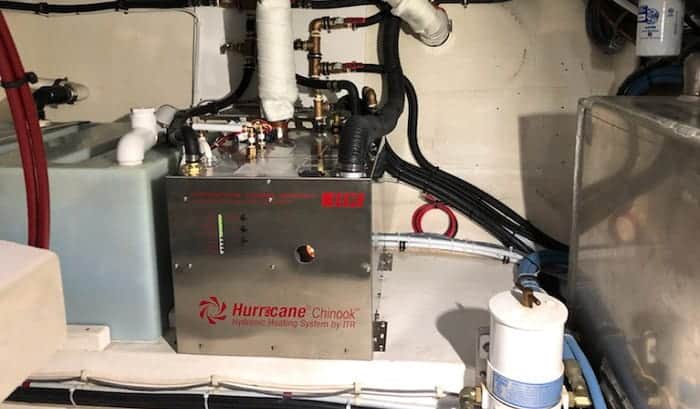
Warm or hot water is essential when sailing as you utilize it for showering and washing up. Just make sure that you get the right heater size so that you can optimize the usage and performance. Unlike residential heaters, marine water heaters don’t consume a lot of energy.
There are numerous marine hot water heaters that you can find. You can avoid confusion by reading this comprehensive review so you’ll be oriented with the important features. Consequently, you can select the most suitable for your boat.
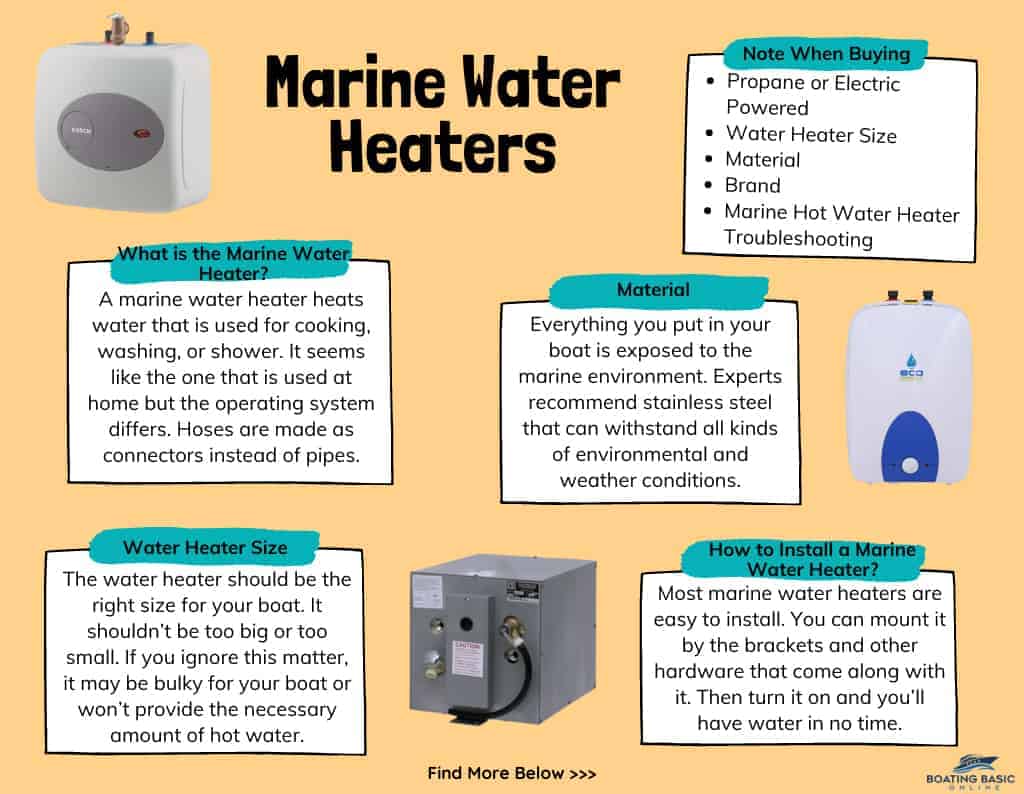
- Works with solar power
- Provides hot water in 5 minutes
- Easy installation
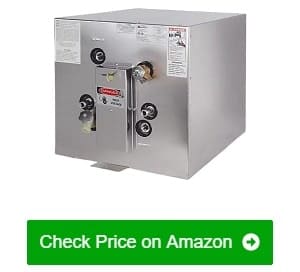
- Doubles the supply of hot water
- Has good-quality parts
- High-quality construction
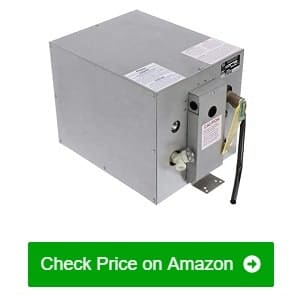
- Durable
- Has 2-year warranty
Table of Contents
1. Whale Premium Water Heater
2. kuuma 11g 120v front exchanger, 3. whale premium water heater capacity, 4. kuuma water heater rear heat exchanger, 5. bosch 7738004996 electric water heater, 6. ecosmart eco mini electric heater, 7. kuuma 120v 6 gallon water heater, 8. whale f700 water heater, 9. bosch es8 tronic 3000 t water heater, 10. whale 68954 seaward hot water heater, 11. suburban 52747a water heater, 12. whale seaward zxc-f600wcwe water heater, factors to consider when choosing marine water heaters, what is the marine water heater, who makes the best marine water heater, how to install a marine water heater, which water heater is better rheem or ao smith, best marine water heater reviews.
You’ll find this product from Whale which is a part of Attwood in several marine water heater reviews due to its dependability. It’s an efficient hot water supplier in my sailboat. I sometimes use solar power to make it work.
When it’s time to take a shower, I only need to wait for 5 minutes to get warm water. That’s why I call it an instant heater! Aside from quickly turning water hot, it can supply you with plenty of it. To prevent water from becoming scalding hot, I added an automatic thermostatic mixing valve to the outlet.
The installation is easy as I mounted it horizontally. It’s like doing plug and play as everything is a match. No tiresome process is required before reaping benefits from this 6-gallon heater that only requires 120V. It’s a relatively compact water heater. Thus, you don’t need a lot of space for it.
- Produces plenty of water supply
- Easy installation or horizontal mounting
- Compact so it take up a lot of space
- Durable because of its premium components
- Adding automatic thermostatic mixing valve to the outlet so that water won’t be scalding hot
Due to this quick marine water heater, the supply of hot water in my boat doubled. It’s lightweight with fiberglass sheets for insulation. This design allows me to remove the case to minimize the space that it occupies.
I was happy that I am able to connect it to the freshwater cooling system of the boat’s engine. Water heating can be done with 110V AC when the engine is not running. However, it’s recommended to fill and cap the pipe with antifreeze when you let it run with AC.
You’ll find black, white, and green wires that have good quality. If you have the same wires in your boat, it’s easy to connect them. Installation is manageable in my case. I figured out what to do after I saw the parts. It has a nice recirculation system that works in producing hot and cold water.
- Lightweight and space saver by removing the case
- Can be connected to the freshwater cooling system of the boat’s engine
- Has good quality parts
- Has a recirculation system for hot and cold water
- Durable due to its high-quality construction
- Needs antifreeze in the pipes when connected to 110V AC
With the 11 gallon capacity of this water heater, I have enough hot water onboard whenever I need it. I think that Whale is a part of Attwood company as the two-year warranty card is addressed to the latter.
It’s a great replacement for my previous heater even though it’s a tad bit larger. Luckily, the plates can be flattened against the case to make some room. This results in decreasing the depth. Although it’s another task, installation is fairly easy. Screwing down plates and horizontal mounting is not that difficult.
Operating this heater starts with 120 volts or 220 volts. It’s flexible when connecting to power sources as it has extra ports. Thus, there are options for you to plug it into the engine coolant or run off the heat engine. The second alternative works even though the boat is underway and it functions without the help of a generator.
- Provide enough supply of hot water onboard
- Fairly easy installation
- Has extra ports for different power sources
- Durable due to rugged construction
- Ignition is protection to prevent harm and accident
- Has plates that may be a tad bit larger than the designated place
- Water turns hot after 45 minutes
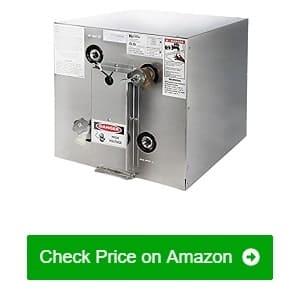
Since the exterior shell of this is composed of marine-grade aluminum, it can last for several years. As I’ve used it for a year with no issues, it’s much better than the other one. I didn’t have to make adjustments as its measurement is similar to my previous water heater.
This has a 6-gallon capacity that never fails to provide the necessary amount of hot water. Thanks to its large diameter and 1,500W heating element! There are other features that I like about it. A high-temperature limiter is present and it has an automatic reset. Also, the circuitry is ignition protected for safe operation.
The heat exchange barbs are found at the back while the fittings and connections are in the front. Installation is relatively easy so I didn’t have to spend a lot of time when going through all the steps. This heater can start working through AC power or engine heat when your vessel is underway.
- Composed of marine-grade aluminum to last for several years
- Provides enough hot water due to 1,500W heating element
- With temperature limiter and automatic reset feature
- The circuitry is ignition protected for safety
- Relatively easy installation
- Works with AC power and engine heat
- Capping off the heat exchanger with anti-freeze so it can supply the needed amount of hot water
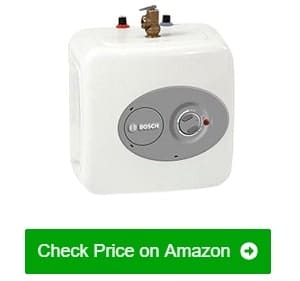
Although this is a mini-tank water heater, it has a number of great features. First and foremost, it’s capable of giving off instant hot water as it can maintain the high temperature. It fascinates me because I don’t need to wait for even a single minute. The warmth is good enough for my outdoor showers. I also use it when washing dishes.
It stands out when it comes to the quantity of hot water. Five to seven gallons can be obtained at 98 degrees Fahrenheit.
Be aware that it may be too hot at first and may likely be so for the first gallon. Despite this minor drawback, it can serve two sinks without compromising performance. Also, the recovery rate is fast. With these abilities, I can say that it’s perfect for heating water from distant faucets.
Since this is tankless, the mounting options are not limited. You may place it on the wall, shelf, or floor. In any way you do it, it will always be easy because of its size. The same reason helps me avoid wasting water as I only get what I need. Just like any other RV marine electric tankless water heater, this saves energy as you only heat the water when necessary.
- Gives hot water in an instant even for two faucets at the same time
- Can provide five to seven gallons of hot water
- With a fast recovery rate
- Mounting options are not a limited and easy installation
- Separate warranties for the unit and the parts
- Makes you save water and energy
- The first gallon of water may be too hot
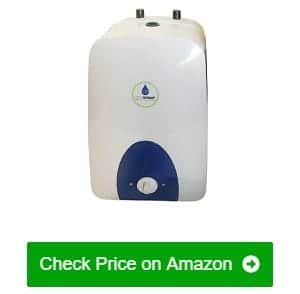
I read some marine hot water heater reviews which convinced me to buy this item. The efficacy of this equipment is not only for household use but onboard as well. Eventually, I wasn’t disappointed. I only need to count seconds to have hot water. Moreover, the performance remains incredible even with a distant faucet.
When onboard, I need hot water to complete menial tasks and quick washing. As such, this heater is a reliable companion. Even my boat bidet with a sprayer became functional because enough supply of warm water came out of it. What’s even better is that this mini tank can give you both hot and warm water.
I like that it’s compact and lightweight with a sleek design and a temperature display. The size of this tank reminds me of a toaster oven. It has pretty good insulation so no energy is wasted. Plug it into a 110-volt outlet and it will start working.
- Heats water in a matter of seconds
- Works on a distant faucet
- Gives water instantly so perfect for quick washing and simple tasks
- Can provide both hot and warm water
- Compact and lightweight with a sleek design and a temperature display
- Has good insulation to not waste energy
- Need to add couplers and tape to secure the connection
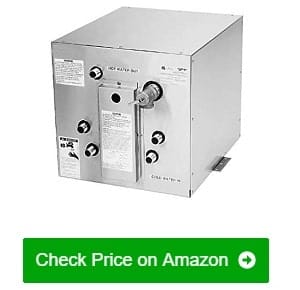
Water heaters made by Kuuma are known for their durability. They are made of aluminum to ensure that you can use them for many years. So, I didn’t think too hard before buying this one. My hunch was right as it turned out to be the perfect replacement for the previous heater in my 1985 O’Day 28 sailboat. I’m enthralled by how it perfectly fits into the cockpit locker due to its side mount feature.
Hot water when cruising the vast sea can be both a necessity and a luxury. Thus, I was prompted to get this heater with great abilities. There are two ways to heat water due to its dual-loop feature. It can be done through the boat’s engine and shore power. When the vessel is underway, you can connect it to AC power. You may even use raw power heating.
It also promotes safe operation, especially for gasoline-powered boats. The credit goes to the circuitry that is ignition protected. There’s a limit to high temperatures and an automatic reset. Hence, you won’t be surprised with scalding hot water. Quick recovery is another wonderful ability from its 1,500W heating element.
- Durable and lasts for many years
- Suits old model vessels
- Works with different power sources
- Promotes safety operation
- Quick recovery of hot water
- Uncomplicated installation
- Separately buying the necessary hardware
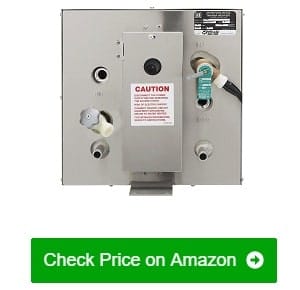
The need to have a huge supply of hot water made me buy this product. You can get 6 gallons or 23 liters from it. It has a thermostat that regulates the electric heating element while it can also produce cold water if you need it.
When heating water, it can reach a temperature of 140 degrees Fahrenheit. But with the temperature-pressure relief valve, the water can’t get too hot. A bilge pump is also added to stop electricity sparks. Since it can dispense both hot and cold water, its design includes waste management.
You can rely on its durability as the inner tank is composed of aluminum and the exterior is of marine-grade stainless steel. These materials guarantee long-term service and strength to face the rigors of the marine environment. That’s why the manufacturer has the confidence to give a two-year warranty to all users.
The double-walled construction is also great as it protects the freshwater supply from contamination. Thus, I don’t worry too much about the water that I keep in my boat.
It’s convenient to just focus on the same area when working on the tank since the fittings and heat exchanger barbs are all situated in the front. Therefore, both the installation and marine hot water heater troubleshooting are easy. Hold-down brackets complete the horizontal mounting of this heater and it’s done with no troubles.
- Contains a huge supply of hot or cold water
- Has parts for safe operation, waste management, and prevention of contamination
- Durable for long-term service
- Has a two-year warranty
- Easy installation and troubleshooting
- Hot water retention for 10 hours
- Very first water release is too hot
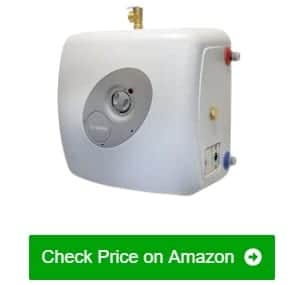
I like this product very much as it’s an effective marine tankless water heater. In just 35 minutes, the entire tank of 7 gallons is filled with hot water! Using it gives me so much ease and convenience. I don’t have to turn it on again and again as the water stays hot.
Installation is super easy since it’s substantially hardwired. I think everyone can do it with no difficulty at all. It can also produce cold water. You may mount it horizontally and vertically. But make sure to prepare enough space for it as it’s not exactly mini. Still, you have the freedom to put it on the wall or the floor.
I mounted it with PEX and once it’s done, hot water came out in just 9 seconds. Thus, it’s right to say that it heats up quickly. The temperature that it handles ranges from 65 to 145 degrees Fahrenheit. I can customize the temperature of hot water as there’s a thermostat swing.
- Can make 7 gallons of hot water
- Easy and convenient to use
- Super easy installation
- Heats up quickly and fast
- With a thermostat swing to customize the temperature
- Energy-efficient even though the faucet is far from the tank
- Prepare enough space before installation as it’s not mini
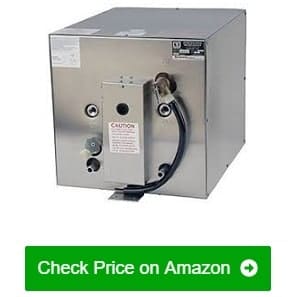
I bought this water heater to make sure that I always have hot water in my boat. Its 11-gallon capacity caught my attention among several other options in the market. It’s a product of the latest technology so it’s capable of bearing 1,500W.
It has a robust construction to withstand harsh marine environments and corrosion. So, I can rely on it in rendering the same performance through time. It simply means unrivaled durability. I can’t help but be astonished by its double-wall heat exchangers and integrated pressure relief valve. Both of these parts guarantee the security of water inside it and the preservation of heat.
Safety operation is also expected from this tank because of its protected ignition. The last thing that I want is to have a piece of equipment that acts up in my boat while sailing. Thankfully, this water heater gives me peace of mind. There’s a safety control to stop the build-up of unsafe temperatures as well.
- Has a large capacity to not run out of hot water
- Has a robust construction for durability
- With parts that keep and preserve hot water
- Safely operates with ignition protected and safety control
- Needs to be installed by two people as this is a large tank
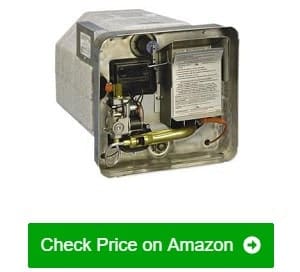
I don’t go for a tankless water heater if I want more pressure and very hot water. The things that I’m looking for are provided by a hardy tank like this one. Since I sail for a couple of days, it serves me well in providing hot water that I use for showers and washing dishes. This is also an RV marine water heater as it’s mostly used by those who permanently live in RVs.
I was able to double up my hot water supply from 6 to 12 gallons. This tank can be powered by propane and 120 volts of electricity. Although it’s big, I’ve noticed that it consumes less propane and it’s quieter too. Due to the adequate supply of hot water, there’s no interruption when taking a shower as long as the power source doesn’t cease to work.
Before mounting this heater, I flushed it first to ensure that the inside is clean. I did some minor adjustments to the plumbing and it didn’t trouble me at all. It doesn’t take much time and effort to complete the installation. After the assembly, give the cold tap water 15 minutes to turn hot.
- A hardy water heater tank
- With a capacity of 12 gallons which means doubling up your hot water supply
- Can be powered by propane or electricity
- Consumes less propane and operates quietly
- Easy installation to produce hot water in 15 minutes
- Not prone to leaks
- Some minor adjustments on plumbing
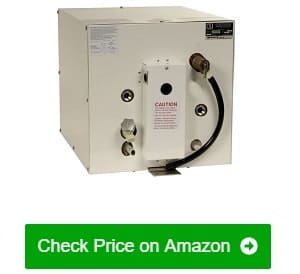
When I go sailing, I see to it that I dock my boat before sunset. But, I sometimes spend the night on the waters and return home the next day. Hence, this 6-gallon water heater is just right for my needs. It can be operated by 120 volt AC or engine coolant heat exchange.
To have constant availability of hot water, there’s a thermostat that regulates the heating temperature at 140 degrees Fahrenheit. You may also get cold water from it because of its 1/2-inch NPT.
The inner tank is made of aluminum while the exterior is of marine galvanized steel. With these premium materials, I know that this tank will be with me for a long time. Durability of a water heater is important for me so I have the assurance that it can take care of my boat’s water supply.
Set it up by horizontal mounting and hold-down brackets that are already attached to the inner tank. I did it with ease by myself. You will have to thoroughly check the fittings and heat exchanger parts to avoid any issue. Fortunately, it’s uncomplicated as they are all placed in the front of the tank.
- Can be run by electricity or a boat’s engine
- Has a thermostat that regulates water temperature
- Durable as it’s made of premium materials
- Easy mounting or installation
- With valves for safety operations
- Thorough checking of the fittings during installation
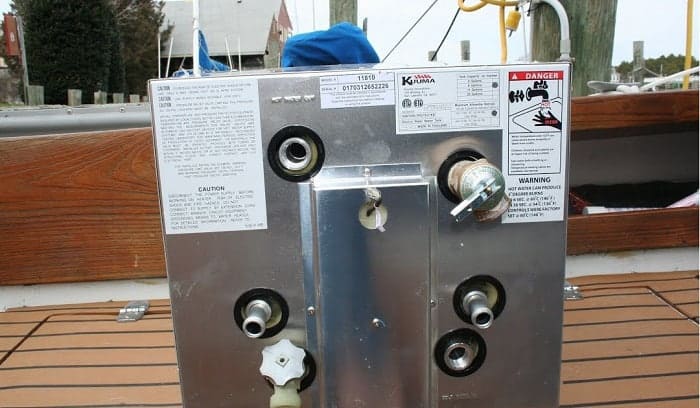
Before buying a water heater, there are two main things that you have to consider. Of course, the size of the heater should match your boat’s size so you have enough space for it. The next thing you have to think about is the number of people onboard. Hold your horses as you can’t just buy a 12V marine water heater if you have a lot of people cruising with you! There are other aspects that you have to ponder as well.
Propane or Electric Powered
Most of the water vessels these days have an electrical system. So, getting an electric-powered water heater is not troublesome. You should know that the heater will always be running without limitations if it’s run by electricity.
When it comes to a propane-powered heater, it has a quick recovery rate even when the temperature is low. You’ll also save on running costs. Some think that electric-powered ones tend to last longer. Nevertheless, propane-powered heaters can keep up.
On the brighter side, you’ll find exceptional water heaters that can be powered by both propane and electricity. So, at any time, you can switch to the power source that suits you best.
Water Heater Size
The water heater should be the right size for your boat. It shouldn’t be too big or too small. If you ignore this matter, it may be bulky for your boat or won’t provide the necessary amount of hot water. If you don’t have ample space for it, go for the tankless type as it’s compact.
Everything you put in your boat is exposed to the marine environment. In this matter, you should consider your boating routine and preference. Experts recommend stainless steel that can withstand all kinds of environmental and weather conditions.
A brand is appealing if it becomes popular due to the satisfaction that it gives buyers. So, settle for a company that has a good reputation and you won’t be disappointed with the quality of their products.
Marine Hot Water Heater Troubleshooting
Be concerned about troubleshooting as it’s important to get the heater fixed in case something goes wrong. Research the product to see if you can handle the necessary troubleshooting steps.
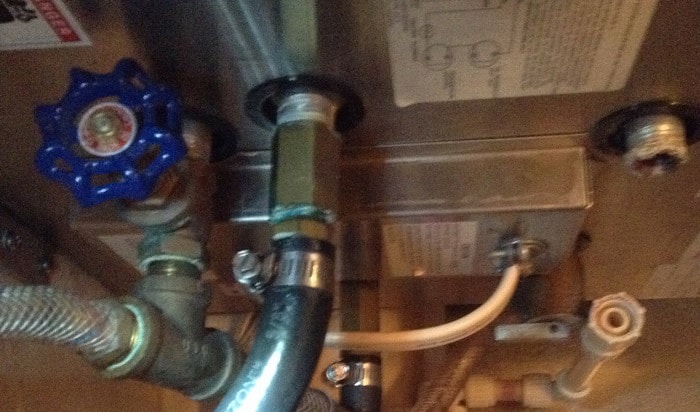
A marine water heater heats water that is used for cooking, washing, or shower. It seems like the one that is used at home but the operating system differs. Hoses are made as connectors instead of pipes .
There are two ways to heat a marine water heater. You can let it run by AC power or marine engine heat. This equipment only needs minimal power as any excess can disrupt ignition. It usually comes as a built-in but selections are in various sizes, patterns, and durability.
Companies become competitive these days. Thus, it’s not only the popular ones that excel in making quality products. Aside from the commonly known Superstor marine water heater and Isotemp water heater, Whale, Kuuma, Bosch, Ecosmart, and Suburban are trustworthy brands in terms of creating marine water heaters.
Most marine water heaters are easy to install. You can follow the steps in the instructional manual but in some instances, you may not need it at all.
You can mount it by the brackets and other hardware that come along with it. Then turn it on and you’ll have water in no time.
Rheem and AO Smith are known as makers of quality water heaters. The former also specializes in crafting air conditioning and air cooling systems while the latter only focuses on water heaters. AO Smith has better customer service than Rheem, which is the primary difference between them.
After reading this review, you know the importance and value of the best marine water heater. It’s an investment with a load of benefits. Hot water is a necessity but it can be luxurious when you’re cruising with your boat. It can make a huge difference in your sailing experience due to the immense comfort that it brings.

“I am James Harvey – founder of Boating Basics Online. It is established with the drive to help out first-time boaters, which are those desiring to explore their way through the water. So if you are new to boating, start from here with me. “

Top 3 Best Solar Panels For Sailboats

Last Updated by
Daniel Wade
June 15, 2022
Choosing whether or not to install solar panels on your sailboat is a big decision. They are not exactly cheap, though they can start to pay themselves off pretty quickly.
This article is going to cover not only why you might want to use solar panels but all the benefits they provide. You will also find a helpful guide on which solar panels would be best for you and your budget. Hopefully, by the end, you will feel confident in your decision to install solar panels on your sailboat and even have an idea of which ones you might like.
Table of contents
Are solar panels on sailboats necessary?
Whether or not you should be installing solar panels on your boat is a matter of choice, not out of necessity. Sailboats get their power from the wind, by harnassing it in their sail. So if you plan to be sailing for the afternoon you probably don’t need solar panels.
You could charge a battery pack from the marina and that will probably see you through several trips. The problems only really start to arise if you are planning to be on your sailboat for longer periods, or even permanently. If you plan to live on your sailboat year-round, even if you spend 80% of it in a marina, you would be better off with some solar panels. Even if it is just as a backup source of power.
Are solar panels on boats safe?
Solar panels are generally pretty safe. They have no moving parts and typically have a very strong protective cover over them so you never come in contact with the electrics themself. So, as a source of power, they are generally pretty safe. The only time they may become unsafe is if they are badly damaged.
Solar panels are often covered by glass plating that keeps them safe. It also helps them absorb sunlight and warmth. This is great, except when the glass breaks. If the glass protective cover on your solar panels should crack and splinter you are at risk of serious injury from sharp shards of glass. Not only is the glass itself dangerous at this point, so are the electronic components inside. They have powerful currents running through them, and if you come in contact with them you may be in for a shock.
Furthermore, if these electronics get wet they can become deadly. Electricity and water do not mix well at all. Being as you are on a sailboat, at sea, the chances of them getting wet is very high. Luckily, the chances of them breaking in the first place are slim to none. The only real way they would break, besides vandalism, is by debris hitting them during a bad storm. There is not often debris at sea, so this shouldn’t be too much of a problem.
What are the benefits of having solar panels on a sailboat?
There are so many great benefits of having solar panels on a sailboat. They can be a lifesaver if you find yourself at sea for a long time. There benefits range from trivial comforts to being the difference between life and death. Here are some of the benefits you might not have considered about having solar panels installed on your sailboat.
Money-saving
Solar panels are not cheap, it is far cheaper to just run a generator or charge your batteries from the marina the whole time. At least, it is in the short term. Over time, it can start to become very expensive. With solar panels, you are looking at a big initial cost (the solar panels themself) and then it’s smooth sailing. You don’t need to pay for power again. Solar panels last for about 40 years before they start to become too inefficient at producing power. The cost of a few solar panels upfront compared to 40 years of marina fees and gasoline for a generator is the financially savvy move.
Emergency power
If you find yourself at sea, the wind dies down (or becomes too strong), and you find yourself stuck bobbing around waiting for more favorable conditions you may run into trouble. Depending on how long you are out there, you may find yourself with dead electronics. Be it a satellite phone, radio, or secondary engine (depending on the boat). Having a set of solar panels and a power bank can be a genuine lifesaver in these situations.
Comfort amenities
Whether you are day sailing or making a week-long voyage, having access to the comforts in life can make the whole journey so much more enjoyable. The amenities may not be available to you without having a constant source of power at sea. Having access to a kettle, tv, videogame system, radio or microwave oven may be the only thing keeping you going at rougher times. As exciting as sailing can be, when you aren’t sailing and are just bobbing around it can be quite dull. The sea is beautiful, but there is only so much time you can spend looking at the water before you miss the comforts of land. With solar panels, you can bring those comforts with you.
Eco-friendly
There are only two alternatives to solar panels. A gasoline generator, and taking power from the grid. Neither of these is good for the environment. Luckily, solar panels are a great third option. Solar panels are completely eco-friendly and are great for the environment. This is not just great for the earth, and your conscience, but for the journey itself. If you are running a gasoline generator at sea you are going to be listening to it thrumming away and smell the burning gasoline. Wouldnt you prefer silence and nothing but the smell of the sea breeze?
How much do solar panels cost?
How much solar panels cost is almost entirely tied into both their voltage/wattage and whether or not they are portable panels. Portable solar panels are great for people who don’t spend a lot of time on their boat or are happy enough living off the marina’s power grid. Permanent solar panels, the kind that may need to professionally installed, can end up costing far more. They are also likely to be far superior and you can pretty much forget about them once they are installed.
Portable solar panels will cost just a few hundred dollars each. You will need a few to be sustainable, but that’s not going to be much of a problem. These portable solar panels can just be rolled out on the deck of your boat, weighed down, and then hooked up to a battery pack. The battery itself here is going to be the most expensive part of the whole set up. A decent-sized battery could set you back a $1000. But, when charged fully it will last days. Even with constant use.
Permanently installed solar panels can cost one or two thousand dollars in some cases. The advantage here though is once they are installed that’s it, you can forget about them. You don’t have to put them up, take them down, and find somewhere to stow them every time they need using. They too will need to be hooked up to a battery, the battery is still only going to cost you $1000. If you are installing permanent solar panels because you plan to be making long voyages, it is ideal to have two or perhaps even three large batteries hooked up to your boat. One to run off, one or two for emergencies.
How do I maintain my solar panels?
Solar panels, unlike gasoline generators, are generally pretty easy to maintain. They have no moving parts and are thus pretty self-sufficient. They don’t need taking apart and they last as long as 40 years. That being said, if they do break they need repairing as soon as possible. The exposed electrics can be deadly when water is thrown into the mix. Which, on a boat, is almost always. The glass cover will need replacing and the electronics inside may need repairing, though not always. Don’t ever attempt to do this yourself unless you are experienced at making these repairs. The cost of hiring someone to do it for you is preferable to being dead. Solar panels have very powerful electric currents, that when in contact with water and yourself can be fatal. As mentioned above, these panels rarely break so you will likely not ever run into this problem. If you do, hire a contractor.
Do my solar panels need cleaning?
Solar panels work by converting the light and heat of the sun into useable power. The process itself is rather complicated but the results are simple to understand. That being said, there are some reasons that your solar panels will stop working as effectively. They all revolve around a lack of sunlight. It could be because it is night time. It could be because it is very cloudy. Or, it could be because they are dirty. If solar panels become too dusty, dirty, and become too covered in grime they stop operating at maximum efficiency. This is not as much of a problem at sea, the sea spray stops dust settling. The biggest thing you will need to clean off your solar panels is salt build-up and slime. This is easy enough to do with some warm soapy water. Freshwater, not seawater. You want to be removing as much salt as possible. Salt is corrosive to electronics, so removing it is important. Never clean your solar panels using pressure washers as they can crack the glass.
Which are the best solar panels for sailing?
There are so many options on the market at various price points. Here are three very different options that will all make good choices, depending on your needs. It is important to consider not just price but power output. Spending a lot of money on solar panels now might not feel ideal, but it is the most cost-effective decision.
1. Renogy Starter Kit
This starter kit is going to be perfect for installing on almost any sized boat. There are four solar panels, each can be fitted permanently to the boat. They can be mounted (and unmounted) easily, for your convenience. They do require a flat surface, but they are small enough that that likely won’t be too much of a problem. This starter kit is very middle of the pack price-wise but should provide enough power for a small to medium-sized vessel easily. It is also possible to buy extra panels individually should you need them.
Wattage: 400/4 (100 per panel)
2. Nature Power Rigid
The nature power rigid is a large, powerful, single solar panel. If you are looking for the right panels to power your entire boat comfortably, these are the ones for you. They are very large so they will need a large flat surface area. alternatively, they can be hung vertically from rails. This is an inefficient way of using them, so you would need to buy more this way. Nature power makes various solar panels so you could find some smaller ones of the same brand to supplement it. This one is not so easy to install, you might need to hire someone to install it for you.
Wattage: 165
3. Nature Power Monocrystalline
Nature power makes a portable solar panel that fits inside a special briefcase. It is perfect for stowing away easily and only taking it out when it is needed. It is decently powerful considering its portable, but there is the inconvenience factor of having to set it up each time. If you planned to buy the nature power rigid, buying one of these portable panels might be ideal for supplementing your power supply when it is especially sunny. Though, it may be cheaper for you to just fit more of the Nature Power Rigids.
Wattage: 120
Hopefully, you now have a good idea about whether solar panels would be right for you and your sailboat. Sailing is great, but the lack of power at sea can be dreadfully boring. Luckily, there are so many great options available on the market. Not just the ones mentioned above. Buying a solar panel is an investment, the initial cost is minor compared to the steady return from all the savings you will make.
Related Articles
I've personally had thousands of questions about sailing and sailboats over the years. As I learn and experience sailing, and the community, I share the answers that work and make sense to me, here on Life of Sailing.
by this author
Sailboat Upgrades
Most Recent

What Does "Sailing By The Lee" Mean?
October 3, 2023

The Best Sailing Schools And Programs: Reviews & Ratings
September 26, 2023
Important Legal Info
Lifeofsailing.com is a participant in the Amazon Services LLC Associates Program, an affiliate advertising program designed to provide a means for sites to earn advertising fees by advertising and linking to Amazon. This site also participates in other affiliate programs and is compensated for referring traffic and business to these companies.
Similar Posts

How To Choose The Right Sailing Instructor
August 16, 2023

Cost To Sail Around The World
May 16, 2023

Small Sailboat Sizes: A Complete Guide
October 30, 2022
Popular Posts

Best Liveaboard Catamaran Sailboats
December 28, 2023

Can a Novice Sail Around the World?
Elizabeth O'Malley

4 Best Electric Outboard Motors

How Long Did It Take The Vikings To Sail To England?

10 Best Sailboat Brands (And Why)
December 20, 2023

7 Best Places To Liveaboard A Sailboat
Get the best sailing content.
Top Rated Posts
Lifeofsailing.com is a participant in the Amazon Services LLC Associates Program, an affiliate advertising program designed to provide a means for sites to earn advertising fees by advertising and linking to Amazon. This site also participates in other affiliate programs and is compensated for referring traffic and business to these companies. (866) 342-SAIL
© 2024 Life of Sailing Email: [email protected] Address: 11816 Inwood Rd #3024 Dallas, TX 75244 Disclaimer Privacy Policy

- Multihull Sailor
- Real Estate
- Maintenance & Hardware
- Water Sports
The Different Types of Solar Panels for Boats
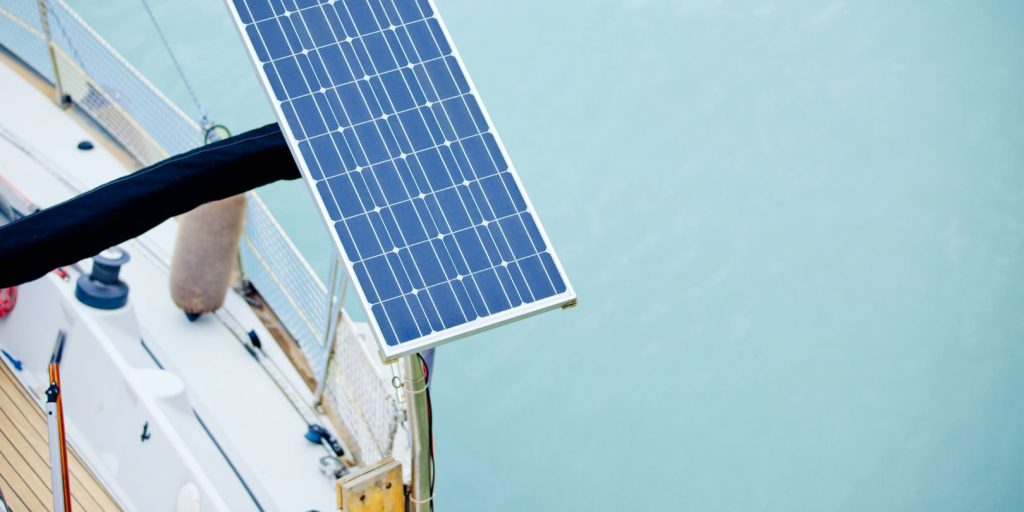
- 1 Monocrystalline Solar Panels
- 2 Polycrystalline Solar Panels
- 3 Thin-Film Solar Panels
- 4 Amorphous Solar Panels
- 5 Semi-Flexible Solar Panels
- 6 Rigid Solar Panels
- 7 Conclusion
Related Posts
As the world’s focus on sustainability intensifies, the allure of harnessing solar power for various applications, including marine settings, has grown significantly. For boat owners and enthusiasts, embracing solar panels offers a gateway to a greener and more self-sufficient way of navigating the open waters. The sun’s natural energy can power boats, reducing reliance on conventional energy sources and minimizing environmental impact.
In this blog, we delve into the diverse world of solar panels for boats , exploring the advantages and characteristics of each type. Whether you sail the vast ocean or cruise along tranquil rivers, understanding the array of solar panel options available will empower you to make informed decisions in embracing renewable energy and charting a course toward a more sustainable future on the waves.
Monocrystalline Solar Panels
Monocrystalline solar panels are known for their efficiency and sleek design, making them popular for boat owners seeking maximum power output in limited spaces. These panels are made from a single crystal structure, allowing them to convert sunlight into electricity efficiently. Monocrystalline panels boast an excellent power-to-size ratio, making them perfect for boats with limited roof or deck space. While they tend to be more expensive than other types, their durability and efficiency make them a wise long-term investment.

Polycrystalline Solar Panels
Polycrystalline solar panels are another prevalent option for marine applications. Unlike monocrystalline panels, polycrystalline panels have multiple crystal structures, slightly reducing their efficiency. However, they are more cost-effective to manufacture, making them a budget-friendly choice for boat owners. Polycrystalline panels are bulkier than monocrystalline panels, so they may require more space for installation. If you have ample deck or roof area on your boat and are looking for an economical solar solution, polycrystalline panels can be an excellent choice.
Thin-Film Solar Panels
Thin-film solar panels are highly versatile and lightweight, making them an attractive option for boats. They are created by depositing thin layers of photovoltaic material on various substrates, such as glass, metal, or plastic. Thin-film panels have lower efficiency than crystalline panels but perform better in low-light conditions, making them suitable for overcast or shaded areas on the boat. The flexibility of thin-film panels allows for easy installation on curved or irregular surfaces, making them an ideal choice for boat owners who value adaptability and space efficiency.
Amorphous Solar Panels
Amorphous solar panels, a subset of thin-film technology, are created by depositing non-crystalline silicon on a substrate. They are highly durable, lightweight, and flexible, making them a perfect fit for marine applications. Amorphous panels perform well in low-light conditions and have a better temperature coefficient than crystalline panels, meaning their efficiency drops less in hot environments. While they may have a lower efficiency overall, their ability to generate power in diverse conditions can be advantageous for long journeys or unpredictable weather conditions.
Semi-Flexible Solar Panels
Semi-flexible solar panels offer a middle ground between traditional rigid and thin-film options. These panels feature a thin layer of solar cells embedded in a flexible plastic or polymer material. Semi-flexible panels can conform to curved surfaces, making them suitable for mounting on boat decks, cabins, or sails. They are lightweight and easy to install, often requiring adhesive rather than bolts. While their efficiency might not match rigid crystalline panels, their versatility and ease of integration make them popular among boat owners.
Rigid Solar Panels
Rigid solar panels, typically monocrystalline or polycrystalline materials, are the most common type in various applications. While they are less flexible than other options, they remain a reliable and efficient choice for boats with ample deck or rooftop space. Rigid panels are durable, weather-resistant, and can deliver higher power outputs. They are ideal for boats with higher energy demands, such as those with multiple electronic devices or appliances.
Solar power is revolutionizing how we generate energy, and boats are no exception to this transformation. As boat owners seek eco-friendly and cost-effective solutions to power their vessels, solar panels offer a reliable and sustainable answer. Understanding the different types of solar panels available for boats is crucial in selecting the right solution for your needs, considering factors like space availability, budget, and desired efficiency. Whether you opt for monocrystalline, polycrystalline, thin-film, amorphous, semi-flexible, or rigid solar panels, embracing solar energy will propel your boat toward a greener and more independent future on the water.
Article Contributors
Sail magazine review team.
SAIL Magazine Review Team reports on best-selling products in sailing and boating. SAIL Magazine is reader-supported: When you buy through links on our site, we may earn an affiliate commission. Artificial Intelligence (large language models) may have been used in the research and creation of the content.
To ensure questions about product testing or a specific article are addressed, please contact [email protected]

- Forums New posts Unanswered threads Register Top Posts Email
- What's new New posts New Posts (legacy) Latest activity New media
- Media New media New comments
- Boat Info Downloads Weekly Quiz Topic FAQ 10000boatnames.com
- Classifieds Sell Your Boat Used Gear for Sale
- Parts General Marine Parts Hunter Beneteau Catalina MacGregor Oday
- Help Terms of Use Monday Mail Subscribe Monday Mail Unsubscribe
Solar Powered Water Heater
- Thread starter Bad Obsession
- Start date Jul 12, 2013
- Forums for All Owners
- Ask All Sailors
Bad Obsession
I was thinking about this during down times last night at work. Wouldn't it be cool if you could build a 5 gallon or 3 gallon water heater that was heated by solar panel. It would be useful for smaller boats driven by outboards or boats without heat exchangers. If you could design it with a temperature shut off so that it would be similar to a charge regulator. Once the desired temp is obtain the panel is turned off. If it was insulated like the water tank in my boat, it would hold hot water long after dark. If I run my engine on my Catalina 30 it heats the water and the water stays hot for most of the night and into the next morning. There are solar water heaters out there, but the design difference that I am thinking of is one where the solar panel is your typical electric panel. It is wired to the water heating element in the water tank. This way it may be smaller. It would be even better if you could run it off of a 20 Watt panel or something similar to that size. The key would be an efficient heating element that would get hot with very little power going into it. If the tank was 3 gallon it would be small enough to heat the water at a good rate, be easily installable in a small area. Does anyone else think that this would be possible and a money making prospect?
The Solar Showers in a bag work great. I doubt that you would be able to get enough juice out of your solar panels to heat your water and charge your batteries. These newer solar showers are better quality than the ones that we used to use 10-15 years ago. http://www.rei.com/product/850733/s...ferralID=fb238f14-eb26-11e2-9dea-001b2166becc
My solar shower is some kind of vinyl plastic water bag that is clear on one side and black on the other. lay it on the deck for an hour in the sun and the water is so hot you have to mix it with cool water to use it. hang it up over your head and there is a short hose with a shower head on the bottom. works good actually.
And then there is this little unit..... http://www.amazon.com/Coleman-Water...60864&sr=8-1&keywords=coleman+water+on+demand
The physics of this quickly tell ya why it is not done.. in rough, round numbers, A typical water heater in a boat is 1400 watts.. to heat the same water amount to the same temperature with a 20 watt electric panel would take at full output, 70 times as long.. so if it takes the shore power about 30 minutes to heat the water, the panel would take 35 hours at full output, which would require around three real world days.. That would take probably another couple of days once ya crank in heat loss overnight.. That is the problem with solar, not enough "energy density"..
I figured that, Kloudie. It is a shame. It would be nice to have a dedicated solar panel that was small enough to work on a small boat but it would power a small solar water heater. If it was three gallons it isn't too much water to deal with but it would still take a while for the element to heat the water with current specifications. Who knows, eventually solar may power most things as technology improves.
You have a potential of about 24000 btu's per square meter per day in the eastern USA and about 20% more in the western USA during July. Converting that to heat depends on many factors.
Exactly, Ross.. the bugger is converting it to electricity and then back to heat.. If ya use a collector that looks kinda like a fridge evaporator (laid out flat and with a black anodize finish and inside an insulated frame with a glass cover), and have a little circulating pump to circulate the water between the tank and the collector, you can actually have a pretty good small solar heater in a space about twice the area of a 20 watt panel. Energy conversion is what eats up efficiency.. using a rig like that takes in heat (infra-red) and uses it directly..
Oblivionboyj
The answer is a solar coil doing this job, not a solar panel. The only electricity needed is to run the pump that pushes water through the coil. A refrigerator coil painted black and cased in a box works great. It's really not a crazy hard project, and pretty cheap. You could also go with a single commercially made coil and build your system around it. I'll try and find links. Edit... This is a commercially made coil... http://www.amazon.com/gp/aw/d/B0041VM58E
Doc_holiday
There was an article in popular mechanics years ago about building one out of an existing tank painted black and installed in a box that opens top and front to expose a foil insulated lined box. When the sun goes down, you close the box keeping the tank warm.
Doc_holiday said: There was an article in popular mechanics years ago about building one out of an existing tank painted black and installed in a box that opens top and front to expose a foil insulated lined box. When the sun goes down, you close the box keeping the tank warm. Click to expand
if you have ever had a black garden hose left full of water out in the sun. You know how hot the water can get inside the hose. Fifty feet of black garden hose coiled flat in an insulated window box would serve as a good collector.
Using 5/8 inch hose it would contain .8 gallons of water. The hose out front gets "hot" in an hour.
Why re-invent the wheel. Solar shower bags can be found for under $10 and they heat up to 5 gallons of water in a couple of hours and can be rolled up and easily stored when not in use.
My thoughts are that it would be cool to add it to an existing fresh water system and have a pressurized system. It would be like any existing boat system where there is a hot water tank into the fresh water system so you have pressurized hot and cold water.
There are 12 volt water heater elements that work with overload shunts on wind gens. That would probably be the way to go. When I circumnavigated, I had a 5 gallon black square chemical container which would get water very hot on a sunny day. It had a spigot on one side near the bottom and we would position it so the spigot was over the open head hatch and we could take hot showers inside the boat. No muss no fuss.
I've been looking at this unit. You hook it up to your existing water heater. They also sell a solar water circulating pump. http://www.amazon.com/MH-37-Marine-...1373848884&sr=8-1&keywords=mh-37+marine+solar
You can wet a couple of dark color towels and place them in plastic bags in the sun. They will get hot and you can wash yourself clean with a quart of water.
The panel is interesting, but how would you circulate the water from the tank without an expensive motor and the power consumption?
Bad Obsession said: The panel is interesting, but how would you circulate the water from the tank without an expensive motor and the power consumption? Click to expand
- This site uses cookies to help personalise content, tailor your experience and to keep you logged in if you register. By continuing to use this site, you are consenting to our use of cookies. Accept Learn more…
- Sign in / Register
- Comparison list
- Solar on the go
Picking the best solar panels for a sailboat: Buyer’s guide
- 18 Aug 2022

You might have already heard of brave sailors that conquer the oceans with nothing but wits and solar panels. For instance, this year 83-year-old Kenichi Horie became the oldest person to sail solo from the US to Japan on a solar-powered boat. These stories are inspiring, but picking panels for your boat yourself can be a small challenge in itself. That’s why we wrote a short article about the best solar panels for sailboats and how to recognize them.
Start from type of solar panels
When it comes to solar panels for sailboats, their weight and size matters more than with PV modules for residential systems. Efficiency is important but power — not that much, because the energy needs of a boat are relatively low. The first thing you’ll have to decide about your panels is their type.
Generally, you’ll choose between thin-film panels and monocrystalline modules. While polycrystalline panels are still around and they are indeed cheaper than mono panels, they are much less efficient, which means they’ll need more space and add more weight to your boat.

Thin-film panels are light and cheap
Thin-film or flexible solar panels bend well and they are very easy to install which makes them a great choice for boats with difficult configurations. Some sailors say that flexible panels are the best choice for fast boats because they don’t impact the aerodynamics of a vessel as much as rigid panels do.
The downside of flexible panels is their low wattage. If there are many appliances on board, you’ll need several panels and you’ll need to find the right place for each of them. They also age faster than rigid panels — a thin-film panel generally lasts for 10-15 years.
Monocrystalline panels are powerful and reliable
Rigid solar modules, monocrystalline and polycrystalline, are heavier and bulkier than thin-film panels. You can fix flexible panels with adhesives, but rigid panels require drilling. They are also more expensive than flexible panels.
On the other hand, monocrystalline panels are the most efficient type of panels which means that they provide more power for less space. Even one powerful mono panel can be enough for everything that you’ve got on board. They are also much more reliable and will survive any storm that is coming your way. A monocrystalline panel lasts for at least 25 years.
Panels for boat should be efficient and sturdy
The best solar panels for sailboats don’t have to be powerful, but they better be efficient — find the number in the datasheet. For rigid panels anything over 18-19% is fine. Panels also should be sturdy enough to withstand seastorms. You generally also want good shading tolerance since panels often get shaded by masts and sails. Finally, good performance in low-light conditions is appreciated.
Picking bifacial panels, 72/144-cell panels or larger, anything too powerful generally doesn't make a lot of sense. Performance at high temperatures matters less than it does with home systems. Warranties also play a lesser role. You won’t be able to make use of them because they generally have effect only for residential installations.
The markets of thin-film and rigid panels are different. Generally, a manufacturer of flexible panels doesn’t offer mono- or poly-panels. Canadian Solar, Q CELLS and Jinko Solar are good choices when it comes to monocrystalline modules for boats. Renogy , WindyNation and PowerFilm make fine thin-film panels.
Do the math before purchase
The amount of power for your boat depends on the number of appliances on your board. There are two main ways to determine the size of installation that you need. You can take a test trip and see how much of your battery’s charge you’ve spent in one day. You can also do the calculations manually: write down all the appliances on the board with their power rating and number of hours in use per day. You can read about it in detail in our article " How much solar power to sail the seas? " It doesn’t make sense to oversize a marine PV system, because all the excess power will just go to waste.
Keep in mind that adding photovoltaics doesn’t make your vessel a solar boat, unless you have a solar-powered motor. You can switch your boat to solar energy fully, especially if it’s small, but you’ll have to calculate your energy needs accordingly.

Once you’ve purchased your panels, you’ll have to install them properly. You can order professional service or do it yourself. The most popular places for solar panels on a boat are a stern rail, masts, deck and canvas. Thin-film panels can even go on the sails. Ideally, you want a place where panels wouldn’t be shaded by masts on any other parts of a boat.
List of solar panels for a sailboat
We’ve asked our engineer to pick the panels that would complement a small boat well. These are his choices:
ZNShine Solar ZXM6-NH120-370/M

Solar panels from ZNShine Solar are inexpensive and fit all kinds of applications, including boat systems. ZXM6-NH120-370/M provides 370 Watts of power with a 19.88% efficiency. It performs well in low-light conditions. Graphene coating increases power generation and allows self-cleaning. The only downside is a lower wind tolerance, compared to other models: it is rated to withstand 2400 Pa pressure which is comparable to 140 mph wind.
Mission Solar MSE345SX5T

MSE 345 is a simple solar panel for all kinds of applications, including boat installations. Mission Solar panels are manufactured in Texas. The module provides 345 Watts of power with 18.7% efficiency. It is certified for high snow (5400 Pa) and wind loads (4000 Pa). The model is resistant to salt mist corrosion.
Suntech STP 365 S

Suntech is a Chinese company that offers quality budget-friendly solar panels. The STP365S model stands out in line because of its great performance in weak light, such as cloudy weather and mornings. It is designed to withstand harsh weather conditions, and the module is certified to tolerate wind of over 170 mph. Half-cut design makes cells sturdier and improves shading tolerance. Overall, this panel earns a place among the best boat solar panels.

Andrey had been a news editor and freelance writer for a number of medias before joining A1SolarStore team. Climate change and its impact on people's lives has always been among his interests and it partially explains his degree in Philosophy and Ethics.
Point Zero Energy solar generators review: Titans
Solar monitoring systems: All under control
Inergy solar generators review: Taking charge
AC vs DC-coupled solar battery systems: Pros and cons
How to clean RV solar panels
Learn about the latest arrivals and discounts first!
By clicking "Subscribe", I agree by electronic signature to: (1) receive marketing and other texts and messages from A1SolarStore, directly or from third parties acting on its behalf, at the email address I entered above; (2) the Terms and Conditions ; and (3) the Privacy Policy .
- BOAT OF THE YEAR
- Newsletters
- Sailboat Reviews
- Boating Safety
- Sails and Rigging
- Maintenance
- Sailing Totem
- Sailor & Galley
- Living Aboard
- Destinations
- Gear & Electronics
- Charter Resources
- Ultimate Boat Giveaway

Adding Solar Power to a Sailboat
- By Emily Fagan
- Updated: October 18, 2019
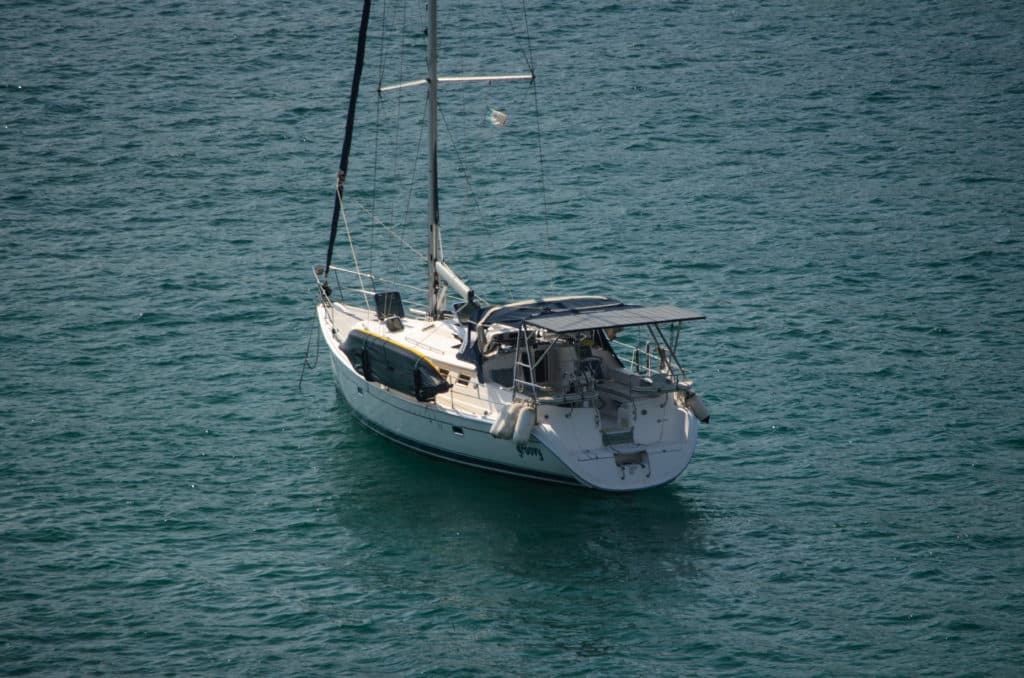
During our nearly four-year cruise of Mexico, my husband, Mark, and I lived almost exclusively on 555 watts of solar power charging a 640-amp-hour house battery bank. We anchored out virtually every night aboard our 2008 Hunter 44DS, Groovy , and relied on the sun for power. During one 10-week stretch, while we waited for a replacement engine alternator to arrive, our boat’s solar panels were our sole source of power. We had no backup charging system to turn to, and yet we lived and sailed comfortably the entire time. Mounting solar panels on a sailboat was not difficult, but a few key decisions made a huge difference in how effective our panels were.
A solar-power installation on a sailboat is made up of two independent systems: one system to charge the batteries, and another system to provide 120-volt AC power for household appliances. In the charging system, the solar panels convert sunlight into electrical current and deliver it to the batteries via a solar charge controller. Similar to a voltage regulator, the charge controller acts as a gatekeeper to protect the batteries from receiving more current than they need as they are being charged. In the AC power system, an inverter or inverter/charger converts the 12-volt DC power in the battery into 120 volts AC whenever it is turned on.
Panel Positioning and Wiring Considerations
One of the biggest challenges for sailors installing solar power on a sailboat is finding a place on the boat where the panels will be shaded as little as possible. Just a few square inches of shade on one panel can render that panel all but inoperable. Unfortunately, between the mast, radome, spreaders and boom, shadows cross the deck all day long, especially as the boat swings back and forth at anchor.
What’s worse, if the panels are wired in series rather than in parallel, this little bit of shade can shut down the entire solar-panel array. When we installed solar power on Groovy , we had already lived exclusively on solar power in an RV for over two years. Our RV solar panels had been wired in series, and we had witnessed the array shutting down current production when just half of one panel was shaded.
Choosing whether to wire the panels in series or parallel on a boat affects the wire gauge required, which is why many solar-power installers lean toward wiring the panels in series. Panels wired in series can be wired all the way to the solar charge controller with a thinner-gauge wire than those wired in parallel. This is because the voltage of panels wired in series is additive, while the current remains constant, so the current flowing is just that of a single panel. In contrast, the current flowing from panels that are wired in parallel is additive, while the voltage across them is not. This means that in a parallel installation, the current going to the charge controller is several times higher and requires much thicker cable to avoid any voltage loss over the length of the wire.
Not only is thinner-gauge wire less expensive, but it is also more supple and easier to work with, making the job of snaking it in and around various crevices in the boat and connecting it to the solar charge controller much less of a struggle. Thus the choice between series and parallel wiring boils down to a trade-off between system performance, expense and ease of solar system installation.
Luckily, the size of the wire can be reduced if higher-voltage solar panels are chosen. Since watts are determined by multiplying volts by amps, a higher-voltage panel that generates the same watts as a lower-voltage panel will produce less current. Therefore, selecting nominal 24-volt panels instead of 12-volt panels allows for the use of thinner wire sizes no matter how they are wired.
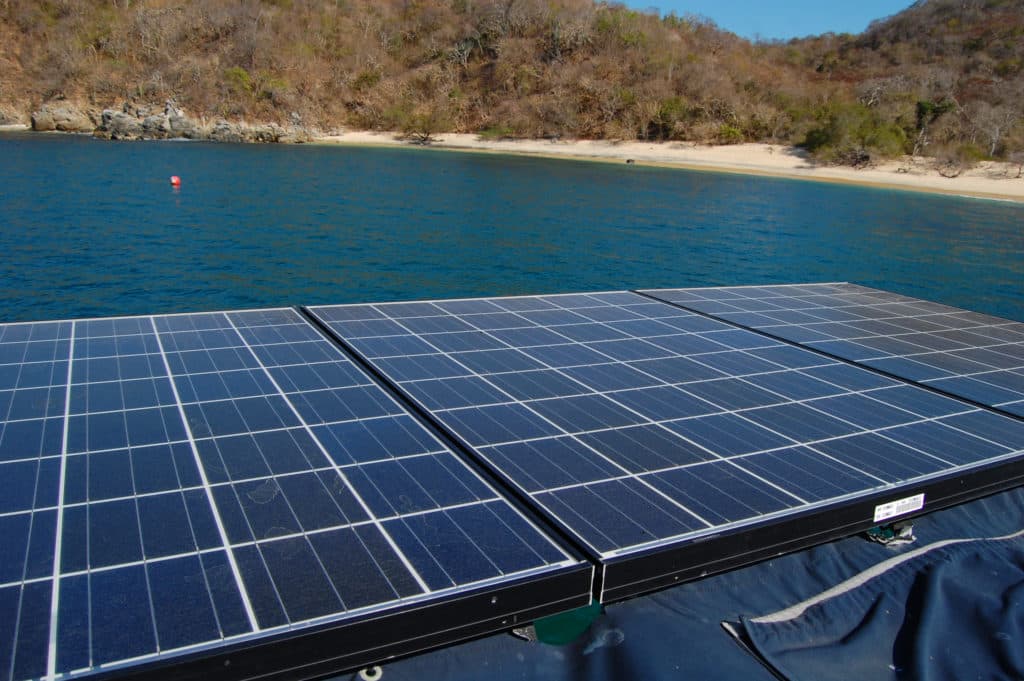
Our Marine Solar Panel Design Choices
In our installation, we decided to mount three 185-watt, 24-volt (nominal) Kyocera solar panels high above the cockpit, well aft of the boom, as far away as possible from potential shade. Our Hunter came with a big, solid stainless-steel arch, and we turned to Alejandro Ulloa, a brilliant metal fabricator at Baja Naval Boatyard in Ensenada, Mexico, to build a polished stainless-steel solar-panel arch extension onto the existing structure. He designed the arch extension with integrated telescoping davits to hoist our dinghy as well as support the solar panels. These davits were strong enough — and the lines and blocks had enough purchase — that either of us could lift our light Porta-Bote dinghy with its 6-horsepower outboard without a winch.
We spaced the panels about a half-inch apart and wired them in parallel. Using two twin-lead wires, we snaked the three positive leads and one common ground down through the inside of the arch tubes so they wouldn’t be visible, and placed wire loom over the exposed wires under the panels.
The junction points for the three parallel panels were on positive and negative bus bars inside a combiner box, all mounted in a cockpit lazarette. Inside the combiner box, we installed three breakers, one for each panel. This gave us the ability to shut off any or all of the panels if we needed to (we never did).
We mounted a Xantrex solar charge controller (model XW MPPT 60-150) in a hanging locker, as close to the batteries as possible, in a spot where it was easy to monitor and program. We ran twin-lead wire from the combiner box to the charge controller and from there to the batteries.
Our boat came with three new 12-volt Mastervolt 4D AGM house batteries, all wired in parallel, for a total of 480 amp-hours of capacity. We wanted a bigger house battery bank, and because it is best for the age, type and size of the batteries to be matched, we added a fourth new Mastervolt 4D AGM house battery, which brought our total to 640 amp-hours. Our batteries were installed at the lowest point in the hull, below the floorboards, and they ran the length of the saloon, from just forward of the companionway stairs to just aft of the V-berth stateroom door.
The best way to charge a bank of batteries that are wired in parallel is to span the entire battery bank with the leads coming from the charge controller. We did this by connecting the positive lead from the charge controller to the positive terminal of the first battery in the bank, and the negative lead from the charge controller to the negative terminal of the last battery. By spanning the entire bank, the batteries were charged equally rather than having the charging current focused on just the first battery in the bank.
We feel that AGM batteries are superior to wet cell (flooded) batteries because they can be installed in any orientation, don’t require maintenance, can’t spill (even in a capsize), and charge more quickly. Our Mastervolt batteries, like almost all AGM batteries on the market, are dual-purpose, combining the very different characteristics of both deep-cycle and start batteries. Our batteries work well, but if we were doing an installation from scratch today, we would consider the new Trojan Reliant AGM batteries. These batteries are engineered strictly for deep-cycle use and have been optimized to provide consistent current and maximize battery life.
Our boat came with a Xantrex Freedom 2,500-watt inverter/charger wired into the boat’s AC wiring system with a transfer switch. The inverter/charger performed two functions. While the boat was disconnected from shore power, it converted the batteries’ 12-volt DC power into 120-volt AC power, allowing us to operate 120-volt appliances, like our microwave. When the boat was connected to shore power, it charged the batteries.
Because this inverter/charger was a modified-sine-wave inverter, mimicking AC current with a stair-stepped square wave, we also had a 600-watt pure-sine-wave inverter to power our potentially more sensitive electronic devices. We chose Exeltech because its inverters produce an electrical signal that is clean enough to power medical equipment, and they are NASA’s choice for both the Russian and American sides of the International Space Station. For simplicity, rather than wiring the inverter into the cabin’s AC wiring, we plugged ordinary household power strips into the AC outlets on the inverter and plugged our appliances into the power strips. Like the charge controller, the inverter must be located as close to the batteries as possible. Ours was under a settee.
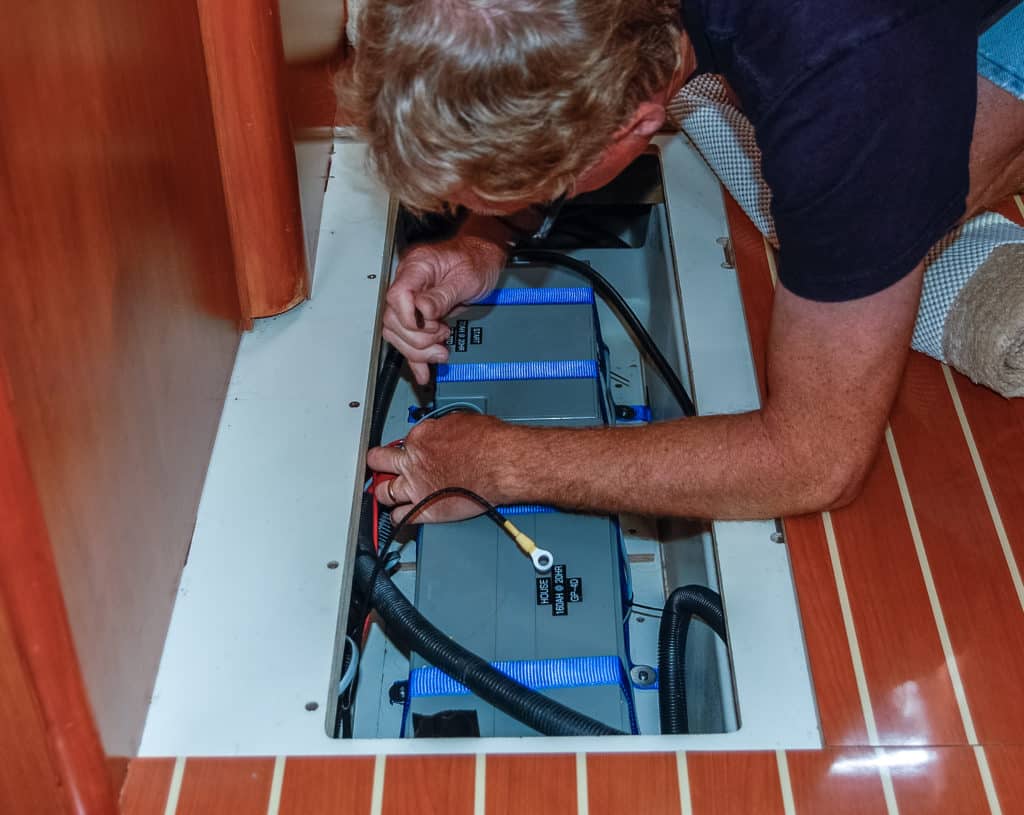
Shade’s Impact on Sailboat Solar Panels
Once our solar installation was completed on our sailboat, we closely observed the effects of shade on our solar-panel array. We were often anchored in an orientation that put the panels in full sun. Just as often, however, we were angled in such a way that shade from the mast and boom covered portions of our panels. It was fascinating to monitor the solar charge controller’s LCD display whenever the sun was forward of the beam — the current from the panels to the batteries fluctuated up and down as we swung at anchor.
Taking notes one morning, we noticed that the charging current was repeatedly creeping up and down between 9.5 and 24.5 amps as the boat moved to and fro. When the entire solar-panel array was in full sun, it generated 24.5 amps of current. When we moved so the mast shaded a portion of one panel, the array generated 15 amps. When it shaded portions of two panels and only one was in full sun, the array produced just 9.5 amps. Of course, it would have been preferable to see a steady 24.5 amps all morning, but this sure beat watching the current drop to zero whenever a shadow crossed a panel.
We discovered that shade makes a huge impact while sailing, too. Surprisingly, it is far worse to have the panels shaded by the sails than to have the panels in full sun but tilted away from its direct rays. One afternoon, we noticed that while we were on a tack that tilted the panels away from the sun, they generated 24.5 amps of current, whereas on a tack where the panels were tilted toward the sun but two of the three were partially shaded by the sails, the current dropped to a mere 10 amps.
Reflections On Our Solar Panel Installation
A wonderful and surprising side benefit of our large solar panels and arch system was that the setup created fabulous shade over the jumpseats at the stern end of the cockpit. Our metal fabricator, Alejandro, placed a support strut at hand-holding height, and sitting in those seats feels secure and comfortable while sailing, no matter the conditions.
After living on solar power for eight years of cruising and land-yacht travel, we’ve learned that you can never have too much solar power. Groovy’s 555 watts was enough to run all our household appliances as needed, including our nearly 4-cubic-foot DC refrigerator, two laptops, a TV/DVD player, and lights at night. However, it was not quite enough power to run all that plus our stand-alone 2.5-cubic-foot DC freezer during the short days and low sun angles of the winter months without supplemental charging from the engine alternator every few days. For the 10 weeks that we did not have a functioning alternator, our solution was to turn off the freezer, which enabled our batteries to reach full charge every afternoon.
Solar power made a world of difference in our cruise. Not only did it allow us to live comfortably and with ample electricity for weeks on end when our engine alternator went on the blink, but as a “set-it-and-forget-it” system, it also gave us the freedom to anchor out for as long as we wished without worrying about the batteries. In our eyes, the solar-panel arch enhanced the beauty and lines of our boat, giving her a sleek and clean appearance. It was true icing on the cake to discover that the panels and arch system also provided much-needed shade over the cockpit and helm from the hot tropical sunshine. If you are preparing for a cruise, consider turning to the sun for electricity and outfitting your sailboat with solar power.
The Installation:
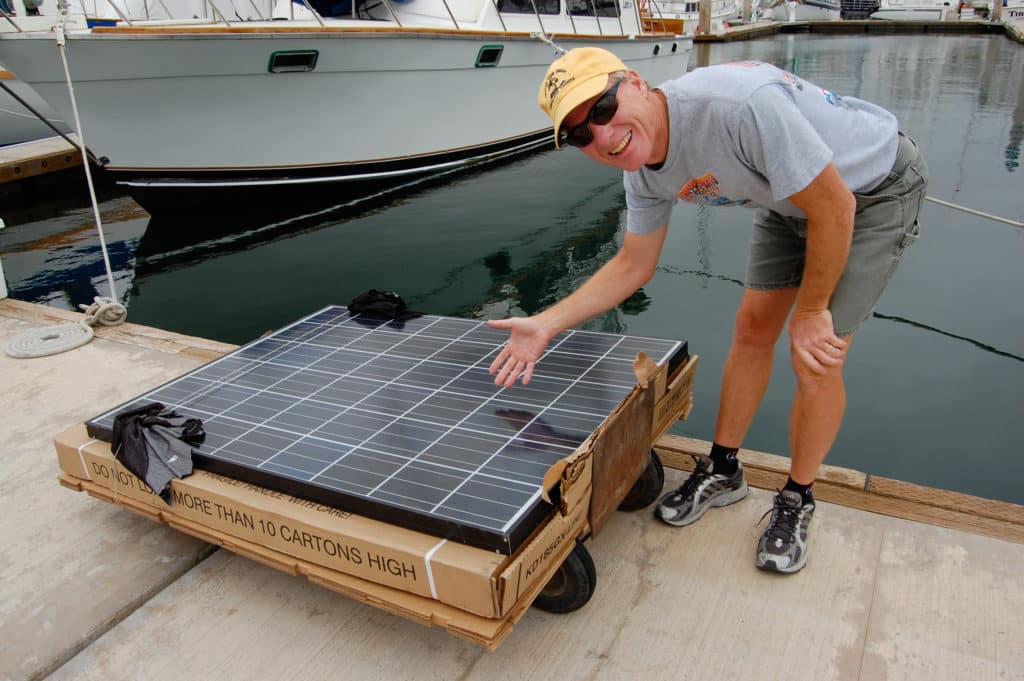
Emily and Mark Fagan offer cruising tips and share their stories and photos on their website, roadslesstraveled.us . They are currently enjoying a land cruise across America aboard an RV.
- More: DIY Sailboat Projects , green sailing , How To , installations , Refits , Sail Green , solar , solar panel , Upgrades
- More How To

Rigging Redo: A Switch to Synthetic

Top Tools for Sailboat Cruising: Must-Have Gear for 2024

Made for Shade: Cockpit Cover Options

Blackwater Wisdom for Holding Tanks
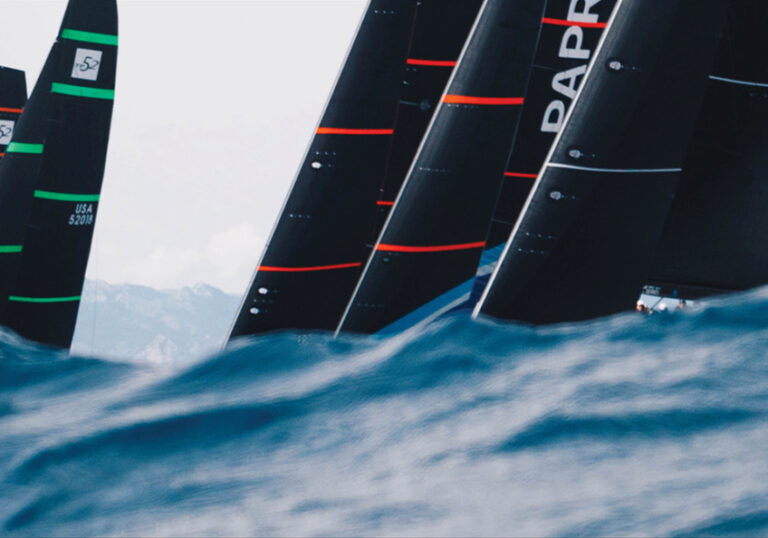
North Sails Parent Company Buys Doyle, Quantum
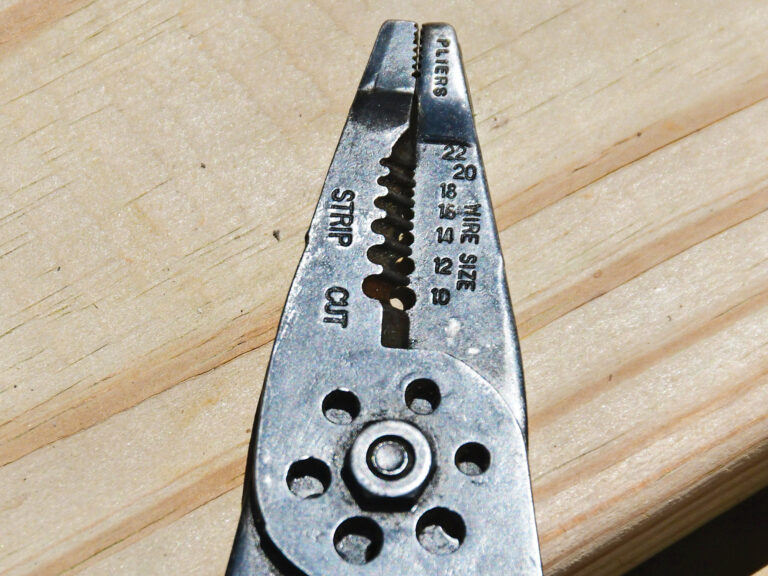
For Sale: 1984 Camper & Nicholsons 58
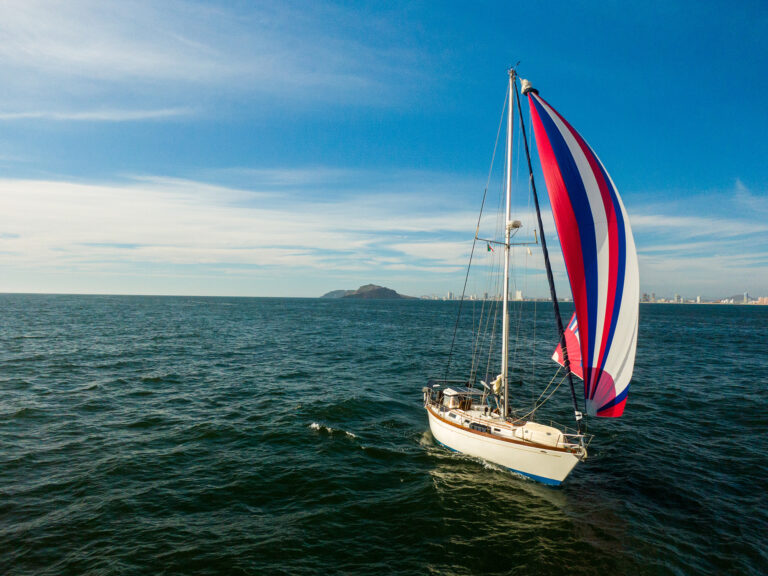
Sailing Avocet : A New Adventure Begins
- Digital Edition
- Customer Service
- Privacy Policy
- Terms of Use
- Email Newsletters
- Cruising World
- Sailing World
- Salt Water Sportsman
- Sport Fishing
- Wakeboarding

6 Best Solar Panels for Sailboats in 2023
Categories Boating

Solar panels are a great way to power your boat and enjoy off-grid benefits. You can use them for charging batteries, running lights, or even providing you with hot water. The best solar panels for sailboats are those that can withstand the harsh marine environment and provide you with clean, quiet energy.
Six best solar panels for sailboats
Here are our top six picks for the best solar panels for sailboats:
Renogy Flexible Solar Panel 175 Watt 12 Volt
This Renogy solar panel is one of the best options for a sailboat. This product has an efficiency rate of 16-18% and will produce an average of 175 watts.
The Renogy flexible solar panel is a durable and lightweight product that can easily mount on any surface.
The best feature of this product is the 10-year warranty that Renogy provides. This solar panel can be used in any weather condition and will not become damaged or broken easily.
The best part about this product is the price. It is one of the most affordable solar panels that you can purchase. This product is perfect for any boat or RV and will provide a reliable energy source.
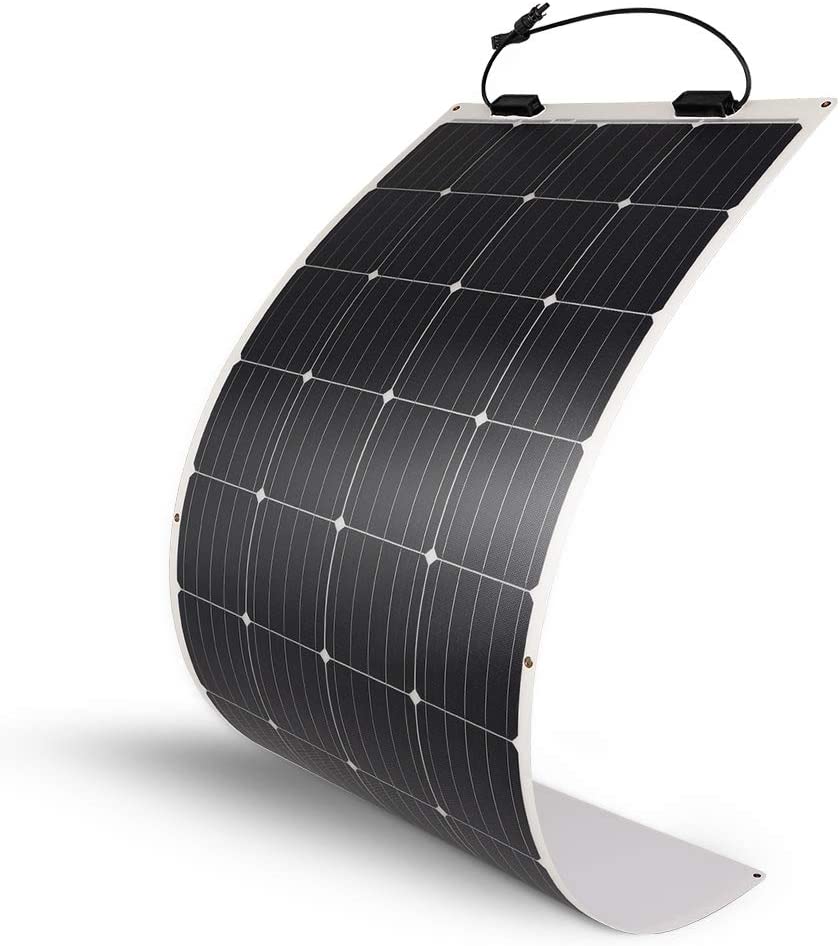
No products found.
HQST 100 Watt 12V Solar Panel
The HQST 100-watt solar panel is one of the best solar panels for sailboats. The HQST 100-watt solar panel can charge multiple batteries and other devices.
The HQST 100-watt solar panel is highly efficient as it can charge multiple batteries and other devices.
The HQST 100-watt solar panel is eco-friendly and durable. The HQST 100-watt solar panel is a one-time investment that will save you money in the long run.
The HQST 100-watt solar panel is water resistant, shockproof, and has an anti-corrosion coating.
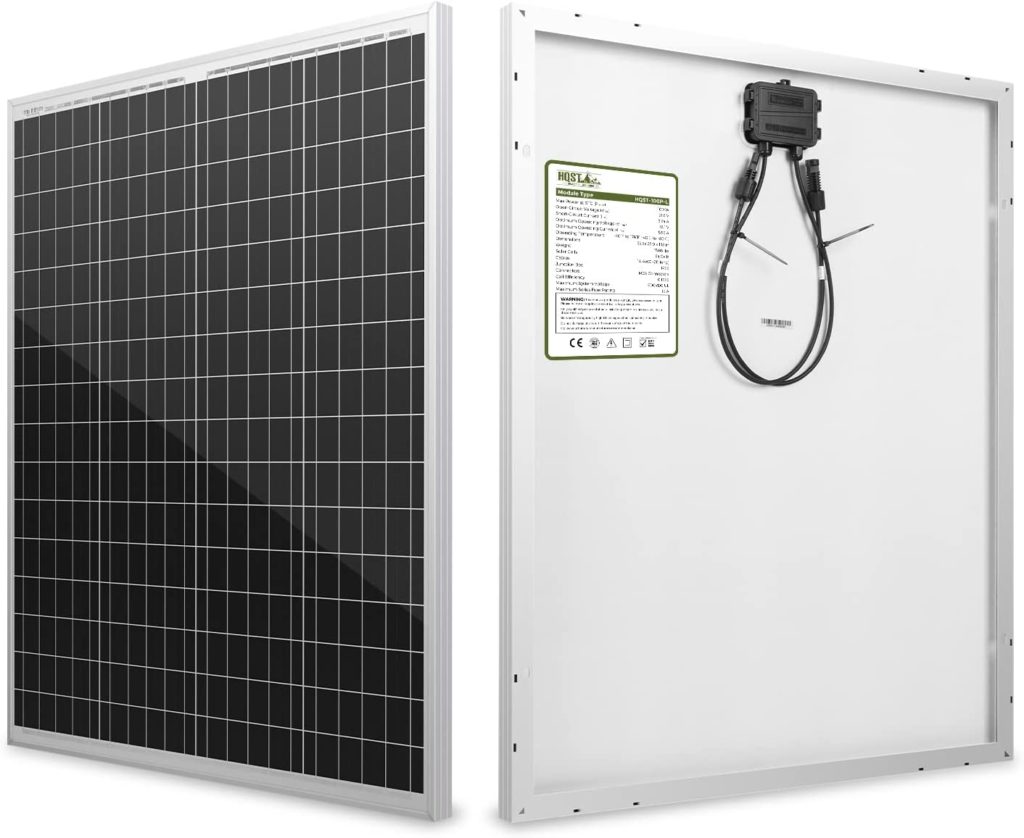
Topsolar Flexible Solar Panel 100W 24V/12V
The Topsolar Flexible Solar Panel 100W 24V/12V is an excellent option for sailboats. It is a practical, semi-flexible, cheap option. The connectors are incredibly robust and withstand lots of wear and tear over time.
The maximum energy absorption is crucial if you want to increase the performance of your solar panel.
The Topsolar Flexible Solar Panel can be mounted on pretty much any vessel, either flat on the surface of your deck or curved around the mast. This is an excellent feature as it allows you to take advantage of the sun’s energy no matter what shape your boat is.
You can use the Topsolar Flexible Solar Panel with the Topsolar Tripod for mounting your boat’s mast.
This is a great option to consider if you want something that will improve your sailboat’s performance without breaking the bank.
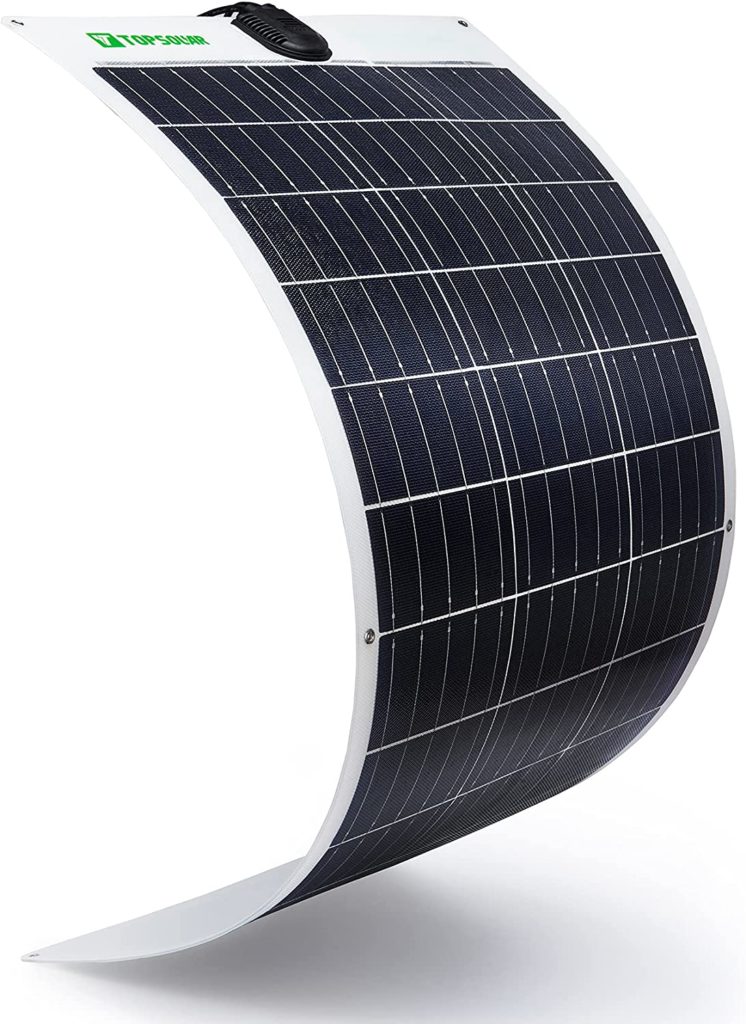
SunPower Flexible 110W Solar Panel
The SunPower Flexible Solar Panel is made with high-quality materials, ensuring durability. The solar panel can be easily portable and flexible. The solar panel has a five-year warranty on power and a two-year warranty on the product.
The solar panel is lightweight and has a durable build. The output quality of the solar panel may deteriorate over time, but you can use the extended warranty to address this issue.
The solar panel is also weatherproof, so the elements will not damage it. The only disadvantage of this solar panel is the price.
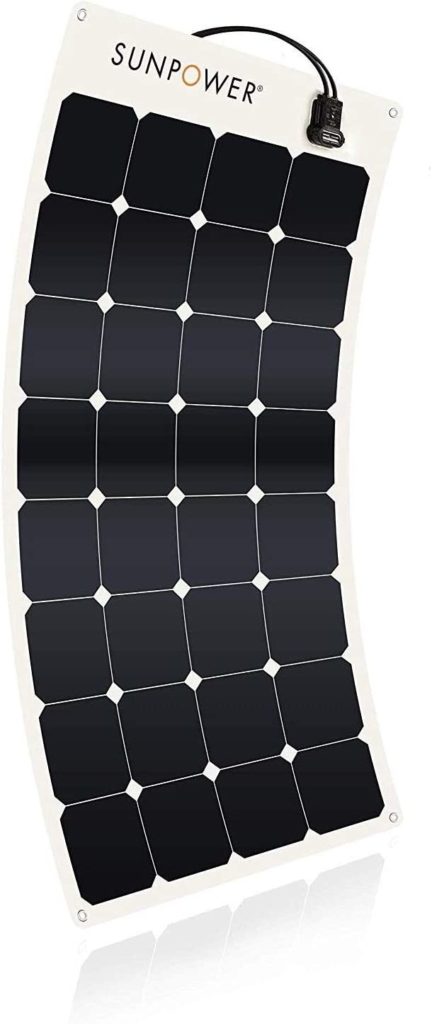
Newpowa 30W Watts 12V Solar Panel
The Newpowa 30W Watts 12V Mono Solar Panel is one of the best solar panels for sailboats. The Newpowa 30W Watts 12V Mono Solar Panel is a high-efficiency solar panel perfect for sailboats.
It is a monocrystalline solar panel that offers a 25-year transferrable warranty against a drop in power output.
The Newpowa 30W Watts 12V Mono Solar Panel is a 100% waterproof solar panel that can protect things when the doors and the soft or hardtop roofs are removed.
The Newpowa 30W Watts 12V Mono Solar Panel is a durable solar panel that can withstand weather conditions and sunlight exposure.
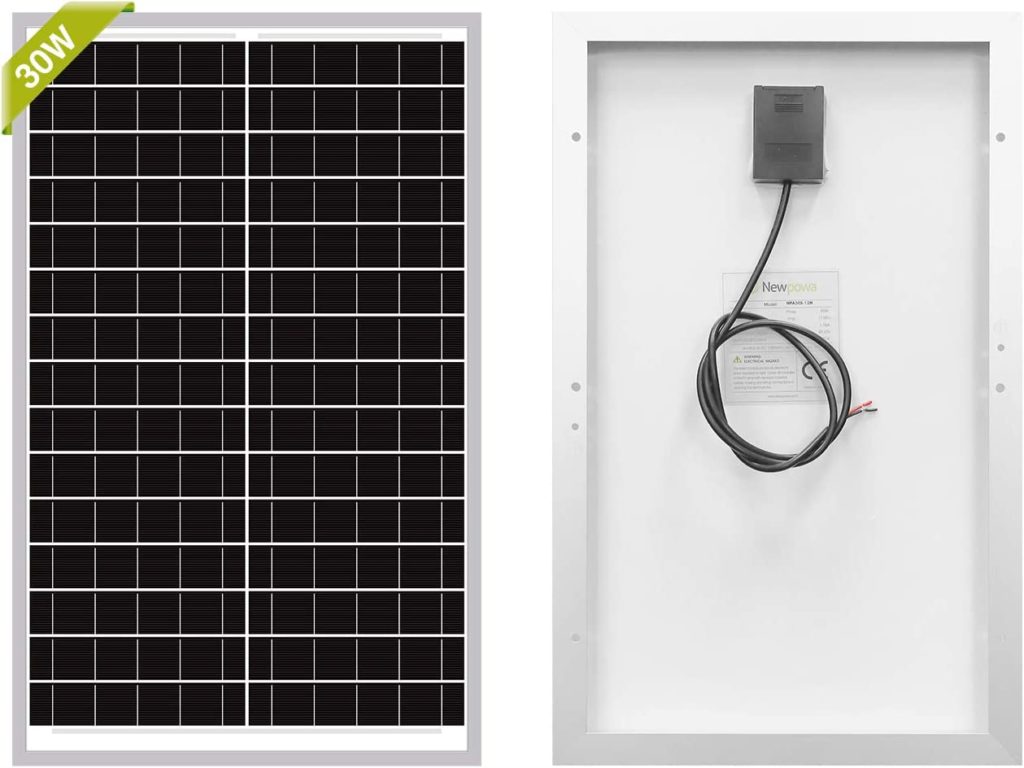
ECO-WORTHY 100 Watt Solar Panel
The ECO-WORTHY 100 Watt Solar Panel is one of the best solar panels for sailboats. This panel type comes with a warranty and IP65 water and dustproof rating.
This solar panel is lightweight (only 13 pounds) and has all the accessories needed to install it on your boat. The panel is easy to install and waterproof, so you don’t have to worry about any damage from the rain or water splashes.
The ECO-WORTHY solar panel is designed to work well with different types of boats. It has everything you need to install on your boat, including a mounting bracket and an MC4 connector cable.
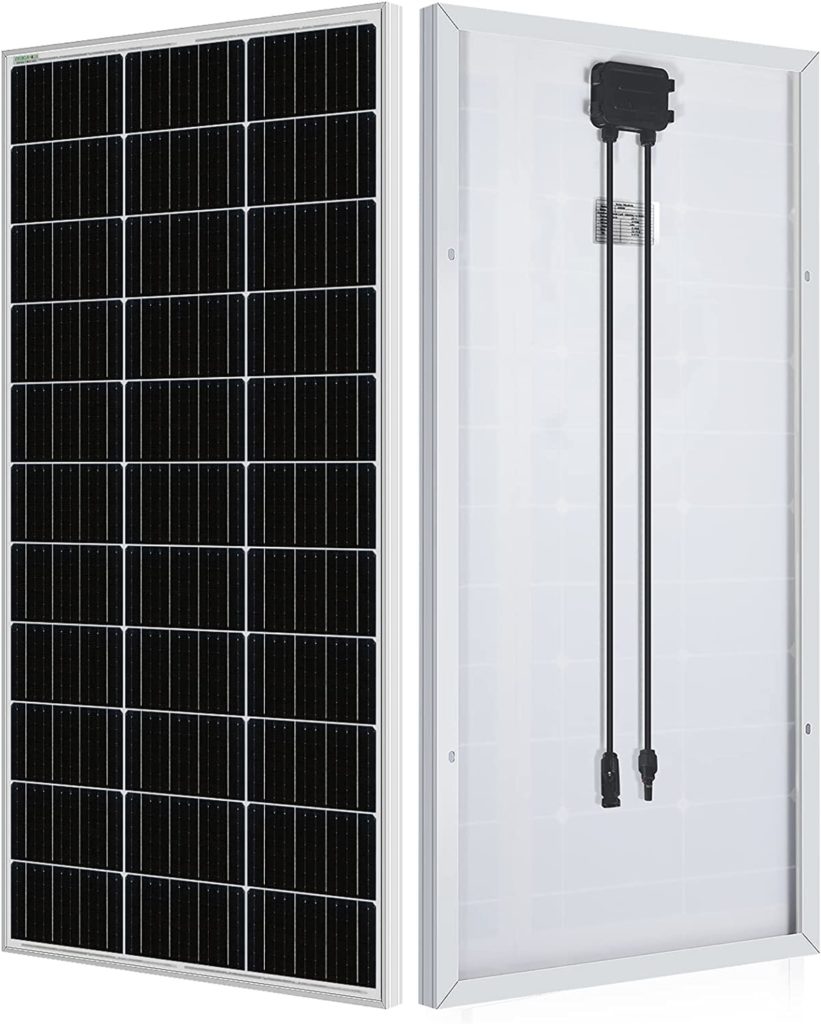
How to choose the right solar panels for your boat
To choose the right solar panels for your boat, you must determine how much power your boat uses. The first step is to determine how many amp hours your appliances use daily.
You can use a battery monitor to measure the energy your fridge, lights, or the other appliances on your boat consume while in use.
After finding the amp hours your boat uses per day, you can determine the wattage of power your solar panels need to produce. For example, if you have a 50-watt panel and use 30 amp hours per day, you would need two 50-watt panels to produce enough power for your needs.
Additional things to consider are whether you need a charge controller and if you have enough unshaded space for your solar panels to absorb the maximum amount of sunlight.
What are Flexible and Rigid Solar Panels?
Rigid solar panels are more efficient but less robust than flexible panels. Monocrystalline cells offer a better output than polycrystalline cells. The output voltage depends on the number of cells on the panel.
Module efficiency is now more often around the 20% mark, as opposed to 12-15% for older models and semi-flexible (up to 20° bend) is usually better than flexible (up to 180° bend).
If the maker offers a 25-year guarantee instead of a 3-5 year one, you can be pretty confident they’re good. Regarding charge controllers, it’s worth paying a little more for a decent MPPT.
How many solar panels do I need for my sailboat?
You will need between 2-8 solar panels for your sailboat. The amount you need depends on the size of your sailboat and how many electronics you need to power. 2-4 panels should be enough if you have a small sailboat. For larger boats with more electronics, 4-8 panels are recommended.
What are the benefits of solar panels for sailboats?
Solar panels are a great alternative to running a gasoline generator or taking power from the grid. Solar panels are eco-friendly and can be a lifesaver if you are at sea for a long time. Solar panels can provide comfort amenities such as access to a tv, microwave oven, etc.
Solar panels are an excellent option for sailboats because they are eco-friendly and have many benefits that make sailing more enjoyable. The best solar panels for sailboats are durable, easy to install, and produce a lot of power.
What are the disadvantages of solar panels for sailboats?
Solar panels for sailboats rely on the sun on to generate electricity. Sailboats are limited in space and cannot carry large solar panels. Solar panels can be expensive to install on a sailboat. Solar panels for sailboats are less efficient on cloudy days.
How much do solar panels for sailboats cost?
Solar panels for sailboats cost a few hundred dollars each. Permanent solar panels can cost one or two thousand dollars in some cases. Portable solar panels can cost just a few hundred dollars each.
If you are installing permanent solar panels because you plan to be making long voyages, it is ideal to have two or perhaps even three large batteries hooked up to your boat.
Do I need a professional to install solar panels for sailboats?
You do not need a professional to install solar panels for sailboats. Solar panels can be installed on sailboats by anyone that is reasonably handy. You can also install solar panels yourself if you are handy.
If you do not feel comfortable installing solar panels yourself, you can hire a professional to install the system for you. An excellent marine electrician will be able to help with your solar panel installation.
Are Solar Panels Safe On Sailboat Boats?
Solar panels are generally safe to use on boats. The panels themselves have a minimal risk of starting fires. However, if they are damaged, they may become unsafe.
Solar panels are covered by glass that keeps them safe from sharp shards of glass. However, if the panel gets wet, it can become deadly due to the combination of electricity and water.
- New Sailboats
- Sailboats 21-30ft
- Sailboats 31-35ft
- Sailboats 36-40ft
- Sailboats Over 40ft
- Sailboats Under 21feet
- used_sailboats
- Apps and Computer Programs
- Communications
- Fishfinders
- Handheld Electronics
- Plotters MFDS Rradar
- Wind, Speed & Depth Instruments
- Anchoring Mooring
- Running Rigging
- Sails Canvas
- Standing Rigging
- Diesel Engines
- Off Grid Energy
- Cleaning Waxing
- DIY Projects
- Repair, Tools & Materials
- Spare Parts
- Tools & Gadgets
- Cabin Comfort
- Ventilation
- Footwear Apparel
- Foul Weather Gear
- Mailport & PS Advisor
- Inside Practical Sailor Blog
- Activate My Web Access
- Reset Password
- Customer Service

- Free Newsletter

Ericson 41 Used Boat Review

Mason 33 Used Boat Review

Beneteau 311, Catalina 310 and Hunter 326 Used Boat Comparison

Maine Cat 41 Used Boat Review

Tips From A First “Sail” on the ICW

Tillerpilot Tips and Safety Cautions

Best Crimpers and Strippers for Fixing Marine Electrical Connectors

Thinking Through a Solar Power Installation

Getting the Most Out of Older Sails

How (Not) to Tie Your Boat to a Dock

Stopping Mainsheet Twist

Working with High-Tech Ropes

Fuel Lift Pump: Easy DIY Diesel Fuel System Diagnostic and Repair

Ensuring Safe Shorepower

Sinking? Check Your Stuffing Box

The Rain Catcher’s Guide

Boat Repairs for the Technically Illiterate

Boat Maintenance for the Technically Illiterate: Part 1

Whats the Best Way to Restore Clear Plastic Windows?

Mastering Precision Drilling: How to Use Drill Guides

Giving Bugs the Big Goodbye

Galley Gadgets for the Cruising Sailor

Those Extras you Don’t Need But Love to Have

UV Clothing: Is It Worth the Hype?

Preparing Yourself for Solo Sailing

How to Select Crew for a Passage or Delivery

Preparing A Boat to Sail Solo

On Watch: This 60-Year-Old Hinckley Pilot 35 is Also a Working…

On Watch: America’s Cup

On Watch: All Eyes on Europe Sail Racing

Dear Readers

Chafe Protection for Dock Lines
- Sailboat Reviews
EXPO Solar Sailer
Designed as a sail trainer, this dinghy with an electric motor and solar panel makes a fun family boat..
Put Gary Hoyt, Ted Hood and Everett Pearson in a canoe and you have the marine industry’s maximum tripartite brain power. The cerebral sparks from these three New England dynamos produced the EXPO Solar Sailer.
Introduced at Sail Expo ’93 in Atlantic City, the EXPO Solar Sailer is a brilliant, purposeful little boat. The object is to “solo” a rank beginner in an hour.
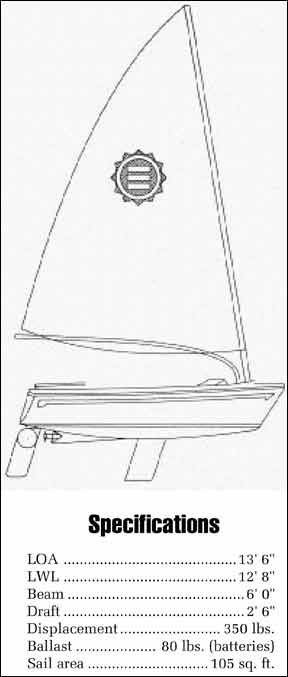
Despite its utility as an educational tool, the 13-1/ 2-foot boat was dubbed by Naval Architect Bob Perry as “an ideal daysailer for a sailor with a relaxed attitude.”
In short, it’s a fun boat-at the other end of the scale from, for instance, a sailboard, which is guaranteed to make anyone look foolish for a couple of weekends.
Design and Construction
The EXPO was conceived by Hoyt (who has a long list of conceptions to his credit), designed by Hood (who needs no introduction) and built by TPI (at present, or one time or another, the builder of J Boats, Aldens, Jeanneau catamarans and Freedoms).
“It takes both the mystery and the fear out of learning to sail,” said Hoyt, who, beginning with the Freedom 40, has spent 20 years trying to take the mystery out of learning to sail. He can talk for hours about how fast, tippy boats intimidate beginners, and that if the sailing industry is serious about attracting newcomers, it must first provide a simple, safe boat that won’t scare off those on the edge of jumping in. That’s the premise of the EXPO Solar Sailer.
Hood calls the EXPO a “cruising Finn dinghy” because the shape of the hull, although beamier, is like the Olympic-class Finn. Pearson is proud of the EXPO’s sturdiness.
The hulls are “Infused Resin Molded” using a vacuum-bagged, injected resin system that creates a powerful, high strength-to-weight composite that should defy decades of hard usage.
She’s a fat little rascal, very stable. Hoyt said that of the 70 built and in use as of late 1994, mostly in educational programs and rental businesses, he knows of only one capsize (by a very hefty gentleman beginner who, in a stiff breeze, jibed and didn’t move until he was in the water).
The white-painted aluminum boom, independent of the rotating mast, arches up and over the cockpit. You’d have to stand up to get clouted. Hoyt has applied for a patent on the free-standing boom.
The 14-pound, tapered carbon fiber mast rotates on a Harken base. The 105-square-foot, loose-footed sail furls on the mast, very easily controlled by a continuous line that serves also as an outhaul. The outhaul and rotating mast also provides reefing, in seconds, with little effort.
On the non-skid deck just forward of the cockpit is a permanently-mounted windvane with color-coded sectors. To trim the sail, the beginner merely matches the color-sector indicated by the vane to the color-coded mainsheet, held in a Harken cam cleat pedestal mounted in the cockpit.
The kick-up rudder is mounted inboard, not only to make it very accessible to the skipper but to give the EXPO a proper yachty look. The daggerboard is easy to operate and has a stopper hole and pin to secure it in the withdrawn position. With the board up and the rudder taking care of itself, the EXPO can simply be winched up on a dock or trailer.
It has a two-way Henderson pump, one channel to pump the hull, the other for the cockpit, which is not self-draining because Hoyt wanted to keep the floor low for adequate leg room. A commodious bow compartment with a well-fitted door provides stowage for a cooler, lunch, foul weather gear and an anchor and rode (in case you want to stop to fish or swim).
The EXPO displaces 350 pounds. It carries up to six persons, but Hoyt conceded that with that load she’d be crowded and sluggish.
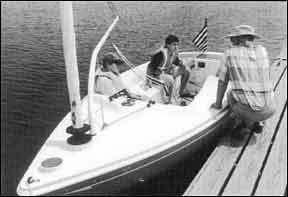
To get away from the dock and motor about, it has an electric engine powered by two securely-anchored gelcell batteries (with an in-line regulator and battery meter) charged by a flexible Unisolar solar panel mounted neatly on the deck aft of the cockpit.
There’s also a built-in 110-volt charging unit. The simple engine switch handle provides three forward speeds and two in reverse. The little prop is protected by a skeg. In flat water, the boat will motor at close to 3 knots (full power) for three hours, five hours at half-speed. Hoyt warned that, under power, it will not work against much of a chop.
Aboard the EXPO, you can shove off and be sailing in five minutes. The EXPO has a hull speed of 4.7 knots, which it should reach in a moderate breeze, even while dragging the little prop on the Minnkoto engine.
The Sail Trainer Test
To try out the EXPO, we dragooned two lads—a 14-year-old experienced Laser racer (he happens to be our son, Kyle Nouse), and Kyle’s 14-year-old buddy, Joe Costa, who knew absolutely nothing about sailing. In fact, he never before had been aboard a sailboat of any kind.
At Newport’s Ida Lewis Yacht Club, the day was hot, with a moderate breeze, with some slightly heavy gusts.
We elected to conduct the test as though we had bought the EXPO for use on an inland lake or bay, taken it out of the crate, assembled it, and said, “It’s all yours, boys.”
Our experienced lad looked over the boat for no more than 10 minutes, tried the furling and the engine controls, pushed the daggerboard down, straightened up the mainsheet, cast off and in less than three minutes was sailing back and forth. Our neophyte, Joe Costa, watched carefully from the dock.
As instructed, Kyle furled the sail and motored back to the dock, with little ado. All he said was, “Awesome.” but he says that often.
With Kyle as a passenger (under orders to not provide even a speck of help or advice), Joe Costa stepped aboard, a bit timorously, settled himself in the starboard aft corner of the cockpit and cast off. He motored away from the dock, hooked the boat into the wind, unfurled the sail, checked the color-coded wind vane and sheet and shouted, “Hey, I’m sailing!”
There was one glitch. Because Joe had an overwhelming tendency to jibe to starboard, round and round and round and round, he skinned too close to shore and ran aground. Kyle quickly furled the sail, put the engine in reverse, pulled up the daggerboard (she draws 2′ 6″ with the board down), backed into deeper water and had Joe sailing again in two or three minutes.
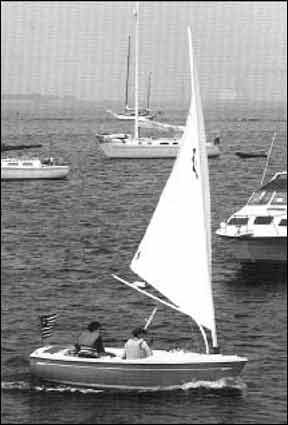
After coming into the dock to collect Joe’s wits and add a little advice about going to weather and the need to shift his butt to the windward side, off the boys went again, this time for a half-hour sail, during which Kyle quickly refined Joe’s skill at tacking, jibing and, most of all, going straight.
Kyle said the most difficult part for Joe was going to weather, keeping the boat moving in a straight line, and then tacking.
It all took about an hour and a half, at the end of which Kyle and Joe were zipping around the harbor, changing helmsmen frequently. When hailed, they responded:
“Do we have to come in now?”
When they did, they were making plans to go out in a Laser, at which time Joe’s learning curve will take a steep upward turn.
What do we think of the EXPO?
It’s a marvelous design, beautifully built with a great rig. With a sail area/displacement ratio of 37 and a displacement/length ratio of 76, it moves very well in most any kind of air. Reefed down a bit, it can handle some fairly heavy going.
However, as a dinghy, the EXPO wouldn’t do. It’s too heavy to tow or lift aboard. It might make a tender or harbor sailor for a big boat that can hoist her aboard, but unshipping the mast would be difficult.
As a teaching tool for both youngsters and adults, this little boat is peerless, squarely meeting its designed intent better than any boat we’ve ever seen. For both commercial usage and for junior programs at yacht clubs and sailing associations, it’s ideal.
We also see the EXPO as simply a very safe, comfortable, inland lake or bay boat that would be a joy to own.
The 1994 price, $6,415, which includes everything, reflects the high quality present in every detail. The price is difficult to compare with other daysailers. Lined up against engineless boats like a Laser ($3,200) or a Sunfish ($2,200), she’s expensive.
However, compared with a 15’ West Wight Potter at $5,995, a Peep Hen 14 with a 4-hp. outboard at $7,245, or an American 14.6 (a Carolina version with an outboard and trailer) at $4,250, the EXPO seems reasonably priced.
RELATED ARTICLES MORE FROM AUTHOR
Leave a reply cancel reply.
Log in to leave a comment
Latest Videos

What’s the Best Sailboats for Beginners?

Why Does A Sailboat Keel Fall Off?

The Perfect Family Sailboat! Hunter 27-2 – Boat Review

Pettit EZ-Poxy – How to Paint a Boat
Latest sailboat review.
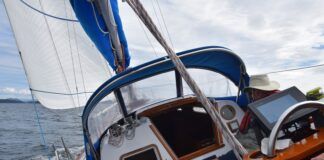
- Privacy Policy
- Do Not Sell My Personal Information
- Online Account Activation
- Privacy Manager
Visit our Popular Forums
- Monohull Sailboats
- Multihull Sailboats
- Powered Boats
- General Sailing
- Antares Yachts
- Fountaine Pajot
- Lagoon Catamarans
Cruising Business
- Boat Classifieds
- General Classifieds
- Crew Positions
- Commercial Posts
- Vendor Spotlight
Life Aboard a Boat
- Provisioning: Food & Drink
- Families, Kids, & Pets Afloat
- Recreation, Entertainment, & Fun
- Boat Ownership & Making a Living
- Liveaboard's Forum
Seamanship, Navigation & Boat Handling
- Seamanship & Boat Handling
- Training, Licensing, & Certification
- Health, Safety, & Related Gear
- Rules of the Road, Regulations, & Red Tape
Engineering & Systems
- Const. / Maint. / Refit
- Product / Service Reviews
- Electronics: Comms / AV
- Electrical: Batts / Gen / Solar
- Lithium Power Systems
- Engines & Propulsion
- Propellers & Drive Systems
- Plumbing / Fixtures
- Deck Hdw: Rigging / Sails
- Aux. Equipment & Dinghy
- Anchoring & Mooring
Photo Categories
- Member Galleries
- Life Onboard
- Sailing in the Wind
- Power Boats
- Cruising Destinations
- Maint. & Boat Building
- Marine Life
- Scuba Diving & Divers
- General Photos
Recent Photos

Listing Categories
- African Cats
- view more »
- Crew Wanted
- Crew Available
- Enhance Your Account
- Meet the Mods
- Meet the Advisors
- Signup for The Daily Cruiser Email

IMAGES
COMMENTS
The circulating water actually cools the solar panel thus increasing its power generation efficiency. On a sunny day, the system will heat water up to 110° F+ at optimum sun angles. You no longer need to run your engine at anchor to heat water. Kits are available for most CMPower rigid panels and many other brands.
SKU Numbers and Options. 1 Panel - 077.0033. 2 Panels - 077.0034. 3 Panels- 077.0035. 4 Panels - 077.0036. Order a Heliatos Boat Solar Water Heater Kit today from SolarParadise.com. Free shipping + free gifts on all of our Heliatos Solar Water Heater Kits. Buy today and get a discount, free shipping, and a free gift! 1.
Engine coolant is passed through a coil inside an insulated hot water tank, known as a calorifier, where it indirectly heats water supplied by the vessel's cold water tank. The calorifier normally has a 240V immersion, so that water can also be heated by a shoreside mains supply. This solar hot water system works very well in most ...
The solar thermal electrics and PV panel, as I installed it, is independent of the boats 12V electrics and solar PV panels. These days, the control electronics is run from the boat 12V supply via a step down module to 5V, but the pump is still on the 19V unregulated 20W panel, switched via a relay. A similar system could be built with a 12V ...
My thought is to circulate (with a low-volume solar-powered pump) warm/hot water through the heater through a modest-sized cabintop collector when not on shorepower. I'm going to experiment with it before next season to see if it's feasible before trying it on the boat. Mobnets. 1973 Chance 32/28 "Westwind".
THE AVAILABLE SPACE. In practical terms, a modern 40ft monohull would have the space for around 1,200W of PV panels (cockpit arch, sprayhood top, deck), maybe 1,500W with the addition of a few portable panels for use at anchor. The 1,200W of fixed position solar array could produce around 360Ah on a sunny summer's day (zero shading) or more ...
This kit contains everything you need to add a high quality solar water heater to your boat. This kit gives you everything you need to connect MH-38 panels directly to your hot water heater, without disconnecting your existing source of heat. Our MH-38 panels include special features to prevent corrosion even in the harshest marine environments:
Solar on a sailboat goes together like hands and gloves, but sailboat solar systems can be installed in a variety of ways. ... Hot Posts. Sailing from Phuket on a Catamaran December 29, 2021; How Fast is Too Fast for an Old Sailboat? December 30, 2021; Taylor's Travels - A Woman's Life on a Sailboat May 12, 2022; Archive. January 2024 (1)
This sailboat water heater is reliable in delivering hot water. It warms water in just a few minutes so you won't have to wait too long. 2. Kuuma 11G 120V Front Exchanger. Due to this quick marine water heater, the supply of hot water in my boat doubled. It's lightweight with fiberglass sheets for insulation.
Nature Power Rigid. The nature power rigid is a large, powerful, single solar panel. If you are looking for the right panels to power your entire boat comfortably, these are the ones for you. They are very large so they will need a large flat surface area. alternatively, they can be hung vertically from rails.
Rigid solar panels, typically monocrystalline or polycrystalline materials, are the most common type in various applications. While they are less flexible than other options, they remain a reliable and efficient choice for boats with ample deck or rooftop space. Rigid panels are durable, weather-resistant, and can deliver higher power outputs.
Jul 12, 2013. #1. I was thinking about this during down times last night at work. Wouldn't it be cool if you could build a 5 gallon or 3 gallon water heater that was heated by solar panel. It would be useful for smaller boats driven by outboards or boats without heat exchangers. If you could design it with a temperature shut off so that it ...
Solar Water Heater Demonstration for Heliatos Solar Panels. Get free hot water for your RV, boat or home. These have been tested to hold up under the most ex...
Mission Solar MSE345SX5T. MSE 345 is a simple solar panel for all kinds of applications, including boat installations. Mission Solar panels are manufactured in Texas. The module provides 345 Watts of power with 18.7% efficiency. It is certified for high snow (5400 Pa) and wind loads (4000 Pa).
A solar-power installation on a sailboat is made up of two independent systems: one system to charge the batteries, and another system to provide 120-volt AC power for household appliances. In the charging system, the solar panels convert sunlight into electrical current and deliver it to the batteries via a solar charge controller.
Newpowa 30W Watts 12V Solar Panel. The Newpowa 30W Watts 12V Mono Solar Panel is one of the best solar panels for sailboats. The Newpowa 30W Watts 12V Mono Solar Panel is a high-efficiency solar panel perfect for sailboats. It is a monocrystalline solar panel that offers a 25-year transferrable warranty against a drop in power output.
In this episode of Sailing A B Sea we are one of five lucky yachts chosen by Green Yachting to receive a Solar Green package which is a 12 volt hot water hea...
Location: Århus, Denmark. Boat: Boreal 47. Posts: 159. Hot water with electricity from solar panels. In another thread, I noticed that some people are contemplating using an inverter to run their water heater on their boats. This is a nice way to use excess power from solar panels. The problem, of course, is that it uses a lots of power ...
Introduced at Sail Expo '93 in Atlantic City, the EXPO Solar Sailer is a brilliant, purposeful little boat. The object is to "solo" a rank beginner in an hour. Despite its utility as an educational tool, the 13-1/ 2-foot boat was dubbed by Naval Architect Bob Perry as "an ideal daysailer for a sailor with a relaxed attitude.".
Our boat has 1.4kW of solar, 840Ah of AGM and 3kW Victron inverter. Our Solar Hot Water cycle system is activated by a manual impulse switch located on our auxiliary electrical panel. This action turns on a digital timer set for 54 minutes to allow heating the water via the inverter and battery system. The time period is more than sufficient for our thermostatically controlled 1.2kW element to ...
Posts: 926. Re: Hot water heating via Lithium battery bank. I use my 2000 watt inverter. It uses 30 amps @ 12v for approximately 3.5 hours to heat to full temp from ambient (6 gallon). If you have a 120v hot water heater you can purchase a 1500 watt @ 240v rated element and swap with your 1500 watt @ 120v element.
Have a Narrowboat? have solar panels? have an immersion heater? Then you need to watch this video for free hot water.Fitting a solar dump so my hot water tan...
With over 30 years in production, the Solaris Hot Water Heater is the first choice for discerning yacht owners. The Solaris Hot Water Heaters are built to last, providing years of ample hot water and comfort on board. Why You Should Invest In A SOLARIS Hot Water Heater: Click here. Long Service Life. 100% Copper Tank & Fittings -Excellent ...